#its a biography of jackson pollock
Text
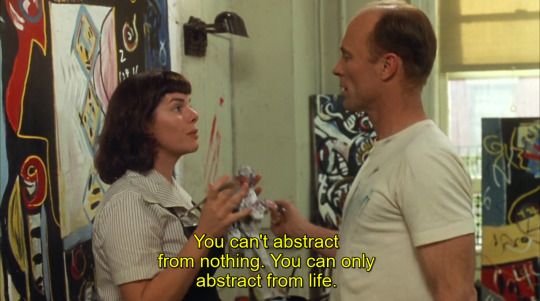

Pollock, (2000)
#Ed harris nailed it in this movie#its a biography of jackson pollock#ed harris#jackson pollock#movie scenes#movie quotes#movie stills#good movie#moviegifs#movie aesthetic#movies#art#abstracart#modern art#film stills#films#filmgifs#cinephile#cinema#netflix#hollywood#90s movies#aesthetics#new york#documentary#filmblr
61 notes
·
View notes
Text
Staying AWARE
Can you name five women artists ?
…
Difficult, right ? Indeed, a vast majority of art exhibitions are of art made by men. Hopefully, nowadays we can see a real improvement. For example, just this year only there were exhibitions of Alice Neel, Rosa Bonheur, Schiaparelli, Frida Khalo and others. How and why did the art’s world opened its gates to women ? Mostly because of figures like the French art historian and curator Camille Morineau. Let’s talk about her project AWARE.
Camille Morineau was the curator of some feminist exhibitions in the last decade : elles@centrepompidou, Niki de St Phalle at the Grand Palais, WomanHouse at the Monnaie de Paris and the retrospective of Françoise Pétrovitch at Landerneau.
AWARE is a non-profit organization created in 2014. AWARE are the initial letters of Archives of Woman Artists Research and Exhibitions. The aim of the project is to make women artists of the 19th and 20th century visible. AWARE gathers a library, a publishing house and a website which is updated weekly. The free website is bilingual, in French and English. There are 850 biographies of women artists with their portraits and some artworks with meticulous captions.
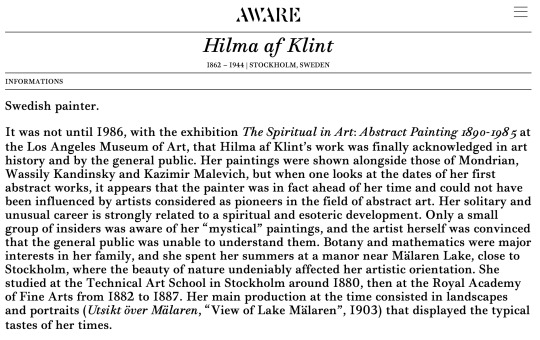
The easy-to-understand website was designed by Lisa Sturacci and Frederic Teschner. The title type font is hollowed in order to create lightness and distinguish it from the content. The font has serif because it is an historical topic ; it gives elegance to the website. The text has a small line space, which creates a quick read. Lastly, good balance is made between texts and images.
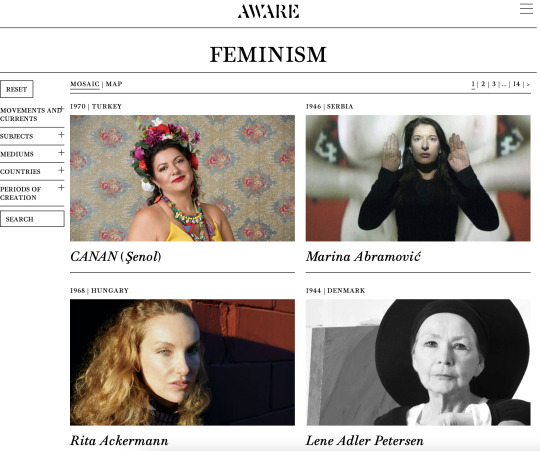
This website is so precious for art historians as well as the mainstream public. Indeed, art history was written mostly by men, which leads to forgetfulness. For example, up until recently, art History considered that abstraction was invented and carried out by men like Mondiran, Kandinski and then Jackson Pollock. But women have largely contributed to it. In art History, the advent of abstraction coincides with the production of Untitled of Wassily Kandinky (1866-1944) in 1910. The work from Swedish painter Hilma Af Klint (1862-1944) was only rediscovered in 1986 during the exhibition The Spiritual in Art : Abstract Painting 1890-1985 at LACMA in Los Angeles, where she was presented as a pioneer of abstraction.
It is also difficult for women to be known independently from their husbands. For example, Sonia Delaunay remained in the shadow of her husband for a long time. AWARE redefines art History and makes women’s artworks visible and really accessible.
To go further, I invite you to visit the website : https://awarewomenartists.com
Klervie - 2238 characters - 04/12/22
2 notes
·
View notes
Text
current super cut of some research that I've been conducting...
it's all super loose notes on what I'm looking into at the minute. I feel like more than I wanted is irrelevant to me, and that I've let things run away a little bit.
I'm hoping that by getting the research out there I'll be able to narrow my research down.
Vitamin P
New perspectives in painting
Publisher: phaidon [2002]
Artists to look up:
Glen brown, again technically so you'll have to ask
Appropriates other art and recreates it as abstracts.
Dispelling the myth of originality presumed genius of artists
Smooth surface, removing painterl texture
Commentary on most people not seeing paintings in the flesh so that’s why his work is flat, it looks the same photographed
John currin [keeeps coming up]:
Mentions glen brown, sigmar polke [came up already], martin kippenberger, alex katz
'I find a cliché and try to belive in it, try to get to where I don't laugh at it'
Historical art references, started with things that were more clearly photographs
Layering image and historical time shows the interchangeable nature of image in contemporary culture
Vladimir dubossarsky and alexander vinogradov
Style described as 'completely synthetic'
Pull from a lot of sources; socialist realism, sots art, and contemporary media culture to soviet 1950s magazines, russian advertising
Starting with russian avant garde the socialist arts, to sots art
Not just a pop art, the nature of sots art is that pop is already a phenomenon to be used
Clement greenberg, 'avant-garde and kitch'
'Unreflective enjoyment' for the audience
Cecilia edefalk
'repetition is the means of emphasising unique quality of a painting'
Works with repetition
Often only the first painting in a series is derived from a photograph, then the next painting becomes the reference for the one after
Takashi murakami
Superflat art style
Richly varied and highly imaginative
Character DOB featured in a lot of his work
Has a team behind him that help him realise his work
Avoids 'production/machine' by producing highly conceptualised and personal blend of pyschcologuy/symbology/aesthetic
Hommage to ed ruscha and jackson pollock with 'splash' series
Amorphous shapes like surrealist painters matta and miro.
Michael raedecker
landscape artist
'im not sure why I do landscapes, maybe its because they make us seem so small'
In door and out door landscapes are empty of people and give the impression of 'pathetic phallacy'
The canvases can be sparse but laid deep with emotional charge because of the abstraction with floating elements
Embroiders his canvases, used to work for fashion designer martin margiela
[alex katz mentioned again]
Looking at the journals in the library - frieze and artforum for artists to research, instead of making a new note page I'm going to put them in here.
*
Follow up: Alex Katz
American figurative painter known for his large-scale simplified images of family and friends
From <https://www.britannica.com/biography/Alex-Katz-American-artist>
1950s, lots of flat art especially in the wake of pop art.
Angles and colour choices added orginality to his work.
While abstract expressionism was thew trendy art at the time, he and a group of his friends still made figurative works.
His work isnt that interesting to me but I can appriciate the scale.
Artforum summer 2022
Laurie simmons
Found from 'clothes make the man ii', 1991 - 2021
Laurie Simmons is an American artist, photographer and filmmaker. Since the mid-1970s, Simmons has staged scenes for her camera with dolls, ventriloquist dummies, objects on legs, and people, to create photographs that reference domestic scenes.
From <https://www.google.com/search?q=laurie+simmons&rlz=1C1GCEA_enGB1028GB1028&oq=Laurie+simmons&aqs=chrome.0.0i355i512j46i512j0i512l8.1231j0j4&sourceid=chrome&ie=UTF-8>
'café of the inner mind' series reminds me of old goosebumbs book covers? I think it's goosebumbs
Look up the goosebumbs artist
'the love doll', I think because the doll is more realistic the idea of domesticity is easier to achieve? But because she's still a doll theres something not quite right that triggers the unncanny sensation, but there is a sense of care with the doll. She doesn’t feel like a sexual object despite the title. Even the photo were shes in the bath isnt that erotic.
Andrea bianconi
[this is mostly for baltic module]
'journey of the chair'
The Sit Down To Have an Idea series first began in the artist's studio in 2016 at a very important moment in Bianconi’s life. No ideas were coming to him that day, and he felt at a creative impasse…Thus was born the manifesto chair, an idea that has touched numerous people to date, and traveled many places since its inception.
From <https://www.barbaradavisgallery.com/andrea-bianconi-journey-of-the-chair.html>
"The journey of my idea chair centers around the notion of the human experience as it relates to being a thinker. The chair becomes a metaphorical object and is representative of the birthplace of ideas; it is where one returns to imagine, think, create."
Chloe wise
'in loveliness of perfect deeds'
A bunch of portraits and a conversation pit made of door mats. Even with the zoom tool its kinda hard for me to read the description of the exhibition. I like the colours and saturation in the paintings. I think that theres a level of distortion or exaggeratoin but I don’t know if that’s just my eyes
Centre pompidou metz
The Centre Pompidou-Metz is a museum of modern and contemporary art located in Metz, capital of Lorraine, France - wikipedia
[in relation to Eva Aeppli}
Eva Aeppli
In 1951, she married Jean Tinguely. “I was scared that his art would suffocate me. That is why I did not want to see any of his works, nor did I want to let myself be influenced by him,” she stated.
https://awarewomenartists.com/en/artiste/eva-aeppli/
In 1952, E. Aeppli moved to Paris with her husband and created marionettes that she sold in toy stores to pay their rent. They lived miserably
Items that need transferred over to the main file at some point.
GWEN PEARSON
FEB 9, 2015
From the article:
A nonspecific fatty acid within the bumblebee mating plug prevents females from remating
Boris Baer,* E. David Morgan,† and Paul Schmid-Hempel*‡
Proc Natl Acad Sci U S A. 2001 Mar 27; 98(7): 3926–3928.
Published online 2001 Mar 13. doi: 10.1073/pnas.061027998
A "spare" compensates for the risk of destruction of the elongated penis of earwigs (Insecta: Dermaptera)
Y Kamimura 1, Y Matsuo
Affiliations expand
PMID: 11771475
DOI: 10.1007/s001140100259
https://pubmed.ncbi.nlm.nih.gov/11771475/
Flower symbolism as female sexual metaphor
Andrea Frownfelter Eastern Michigan University
Recommended Citation:
Frownfelter, Andrea, "Flower symbolism as female sexual metaphor" (2010). Senior Honors Theses & Projects. 238.
Utopias (Introduction)
Name of Author: David Evans & Noble, Richard. & Whitechapel Art Gallery,
Name of Publisher: Whitechapel Gallery
'Pictures' was the forerunner of an appropriationist current that became strongly associated with certain commercial galleries in New York
Walter Benjamin… photography destroying the aura of traditional art, as well as being an accessible, reproducible medium that had emancipatory potential; all arguments that were used to characterize photographic appropriation as an inherently subversive activity
the assumption was that appropriation art was a key component of nothing less than The Anti-Aesthetic, Art After Modernism, Postmodemism… thoroughly institutionalized by the 1970s, and that an alternative had to be formulated urgently
Matthew Teitelbaum's preface most explicitly sees continuities in the shared attempts to represent 'the realities of a modern, urban lifestyle' and 'the fantasy and desire of a consumer age'.
The Feminist Critique section … that visual culture is one of the principal sites where gender relations are produced and reproduced;
Work often utilising stereotypes and parodies that fall into cliches
Appropriation was integral to colonialism
Postcolonialism section is the re-taking of that which was possessed without authority
Malek Alloula's book The Colonial Harem (1981 )
Vailed and unveiled tographs of women were marketed in France to show off the colony. Alloula's commentry shows that these post cards should be 'returned to sender'
Making contemporary art: how modern artists think and work
Author: linda weintraub
Publisher: Thames and hudson
[I like the way that the book is broken down, I think being able to compare different artists being written about is helping me to understand the topics a bit better]
Notes along with the chapter titles [so that I can finally hand in this godsforsaken book]
Scoping an audience:
Choosing a constituant
One for all
Thomas kinkade
Focus on a mass market, kinkade has arranged his private and public life so that it conforms to the vision of his art so that he remains palatable to the largest audience he can
There was a point in American history where 'every' home featured some of kinkade's work, he has exclusivity deals that means that his work can be sold as prints to teacups, blankets to sofa upholstery
Wants people to be able to lose themselves in the fantasy of his art work and find a home there
One for some
Issac julien
Black, gay man into kink
Makes art for himself and those that would fall into his subcultures, its niche and click-y
Some of his work excludes the audience of purpose so that they challenge some of they perceptions by acting as voyeurs
One on one
Skip schuckermann
All art works are made with the client in mind, they are personal, intractable only for the person that was in mind at the time.
The works are non permanent so they are only for one person to enjoy in that moment. The art is seen by one and the one is seen by the art
[ive not really read enough of this im not going to lie, but the headers are kinda self explanatory I think?]
COMMUNICATING WITH THE AUDIENCE
Implicit Meanings-
-Metaphor and Symbol: Michal Rovner
Explicit Meanings-
-Instructional Maps, Notes, and Diagrams: Matthew Ritchie*
Obscured Meanings
--Squirming into Truth's Cracks: Eve Andrée Laramée*
RELATING TO THE AUDIENCE
Disrupting Assumptions: Charles Ray
Instilling Confidence and Inspiring Laughter: Will Schade
Imposing Corporal Punishment: Armaldo Morales*
Providing Free Food: Rirkrit Tiravanija*
Eliciting Secrets: Gillian Wearing
SOURCING INSPIRATION
INTERNAL SOURCES OF INSPIRATION
Soul-
Genus Fusion: Jan Harrison*
Harrison makes some cool clay sculptures, I think that I'll add her to my list of artists to research so that theres a bit of linking and it'll help my context web.
Emotion--
Rage Against Female Gullibility: Pipilotti Rist
Imagination
-Inspiring Inspiration: Julian LaVerdiere*
EXTERNAL SOURCES OF INSPIRATION
Corporate Hype, Spiritual Cool, Military Heat, Global Warming: Scott Grieger*
Apartheid and Redemption: William Kentridge*
The Kaleidoscope of Black Experience: Chris Ofili
First Moments in Art History: Hubert Duprat
EXTERNAL AND INTERNAL SOURCES OF INSPIRATION
History, Geography, Sensuality, Cosmology: Thomas Joshua Cooper*
CRAFTING AN ARTISTIC "SELF"
Disclosing Biography-Unabridged and Uncensored: Nan Goldin
Inventing Biography-Fictionalized Fact and Factualized Fiction: Kim Jones
Transcending Biography--Woman of Allah, Resident of Chinatown: Shirin Nesha
Epitomizing Biography-_Single White Female: Vanessa Beecroft
EXPRESSING AN ARTISTIC ATTITUDE
Obeying Ants: Yukinori Yanagi
Spoofing Biblical Miracles to Inspire Christian Faith: Reverend Ethan Acres"
Nurturing Data Bodies: Marcia Lyons"
Communicating Through Inexpressiveness: Lorna Simpson
Being Gently Subversive: Marco Maggi
CHOOSING A MISSION
Creating Time for Busy People: Victoria Vesna*
Fostering International Reconciliation: Wend Gu*
Inducing Empathy: Tony Oursler"
Envisioning Nirvana: Mariko Mori
Supplying an Anarchist's Arsenal: Gregory Green*
Updating Humanity's Collective Dread: China Adams*
Creating a Life: Alix Lambert
MEASURING SUCCESS
Ecological Success-
Honoring Water: Betsy Damon
Pious Success--
Eliminating Meaning: Xu Bing
Political Success
-Diffusing Concentrations of Power: Daniel Joseph Martinez*
Sensual Success-
-Deflecting Media Attention: Michelle Lopez*
Strategic Success
-Creating Resistance: Matthew Barney
Gilda Williams, How to Write about Contemporary Art
Williams, G 2014, How to Write About Contemporary Art, Thames & Hudson, Ltd., Available from: ProQuest Ebook Central. [3 November 2022].
Section Two: The three jobs of communicative art writing
The three jobs of communicative art-writing
All art-writers can concoct a written response to art (the easy part). Good writers show where that response came from, and convince of its validity (the hard part; discussed in more detail in ‘How to substantiate your ideas’). Communicative writing about artworks breaks down into three tasks, each answering a question:
Q 1 What is it?
( What does it look like? How is it made? What happened? ) Job 1: Keep your description of the art brief and be specific. Look closely for meaningful details or key artist decisions that created this artwork, perhaps regarding materials; size; selection of participants; placement. Be selective; avoid overindulging in minutiae, or producing list-like descriptions that are cumbersome to read and largely inconsequential to job 2.
Q 2 What might this mean?
( How does the form or event carry meaning? ) Job 2: Join the dots; explain where this meaningful idea is observed in the artwork itself. Weak art-writers will claim great meanings for artworks without tracing for the reader where these might originate materially in the work (job 1) or how they might connect to the viewer’s interests (job 3).
Q 3 Why does this matter to the world at large?
( What, finally, does this artwork or experience contribute— if anything— to the world? Or, to put it bluntly: so what? )
Job 3: Keep it reasonable and traceable to jobs 1 and 2. Answering this final question—‘so what?’—entails some original thought. And remember that the achievements of even good art can be relatively modest; that’s OK.
> The three jobs of communicative art-writing
Here is a short extract from a catalogue text by critic and curator Okwui Enwezor.
In the late 1970s, [Craigie] Horsfield commenced one of the most sustained and unique artistic investigations around the governing relationship between photography and temporality. Working with a large-format camera, he traveled to pre-Solidarity Poland, specifically to the industrial city of Krakow, then in the throes of industrial decline and labor agitation [2]. There he began shooting a series of ponderous and, in some cases, theatrically anti-heroic black-and-white photographs comprising portraits, deserted street scenes and machinery
Section Three: How to write an artist's statement
More so critics of things to avoid than anything directly meaningful. I know not to be too cliché or to over complicate what I write.
0 notes
Photo
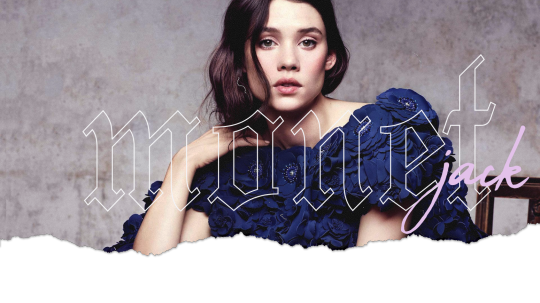
Jacqueline “Jack” Devereux (FC: Astrid Berges-Frisbey)
Pronouns: She/Her
Rank: Apollo
Skill Set Strengths: Gymnastics and Acrobatics, Art and General Counterfeiting, Linguistics, Surveillance, Long Cons
Areas of Opportunity: Smuggling, Operational Organization, and History
Weaknesses: Marksmanship, Hand-to-Hand Combat, and Technological Aptitude
Positive Traits: Disciplined, Calculated, Careful, Balanced, and Intelligent
Negative Traits: Cold, Frigid, Impersonal, Disloyal, and Snobbish
Timeline
Born October 22nd, 1988 in Nice, France to well-to-do French/Spanish aristocracy on the verge of financial ruin
Child of mixed trades - a passion for fine arts, but a talent for gymnastics
Begins competing as a gymnast, earnings gold and silver trophies. Nearly qualified for the Olympics, before an injury and growing dependence on pain killers disqualify her from competition (Age 19)
Earns a scholarship at The Royal College of Art in London, England and emerges with a Fine Arts Degree (Age 23)
Employed as a junior, art restorer for the National Gallery when she catches a counterfeit art piece - catching the attention of Pantheon’s ranks
Joins Pantheon and is placed as an Apollo (Age 27)
The Pantheon’s go-to for art counterfeiting and cons requiring steady hands and athletic flexibility
Languages Spoken
French (Native)
Spanish (Native)
English (Fluent)
Portuguese
German
Mandarin
Italian
Learning Japanese and Cantonese
Character Parallels
Marcia Roy
Olenna Tyrell
Amy Dunne
Mystique
Black Widow
Blair Waldorf
Full Biography
There was a certain, gilded path for the members of Spanish aristocracy. A life that promised importance, lineage, and relevance - long after one had come and gone from the world. It was an old world ideal, but for Duque Lorenzo Jiménez, it remained the expectation. Never mind that the Jiménez’s finances were built on the dwindling foundation of ancestral wealth. He would argue that nobility is synonymous with grandeur. They simply needed to show it to the world. To dig within, and shine. In the bloom of young love, Marianne Devereux promised just that. A highly accomplished painter from a well-to-do family from the South of France; the artist encapsulated what Lorenzo wanted for himself. A grand existence of popularity and influence, shrouded by the classist structures he enjoyed so well. The promise of a son came soon after their wedding, cleverly picking the name ‘Jackson’ after the Pollock painter. But a misread sonogram brings a surprise, and in his place, is her. It’s Jacqueline, they decide. However, the affectionate nickname ‘Jack’ was solidified throughout Marianne’s pregnancy - and it sticks.
Life is not without its share of disappointments, and Jack is exposed to the tumultuous nature of her parents’ marriage. At a young age, the cracks began to appear over the polished glass of the couple. Her father’s taste for champagne, caviar, and excess slowly but surely diminished their financial status. A man of privilege, who never knew a day’s work in his life, placed the blame on his partner. An art career that once showed promise, proved fruitless in the years to come. Year after year, her popularity dwindled. And with it, the financial prosperity of the young family. In the cold, imposing ancestral home - Jack lived in relative solitude. When the marble halls weren’t shaking with her father’s wrath and her mother’s cool resentment, it rang a hollow silence. Something cold and imposing, in all that surrounded her. A cold state of being, as it turned out, made for survival. Jack managed through the toxicity of her family, by virtue of numbness. The singular source of emotional expression, brought by a paint brush and a canvas.
It was the first of many things that her father would take away from her. In its place, is the rigor of gymnastics. What began as a six-year-old’s hobby, evolved into a vocation. Sure, Jack was a tried and true natural - likely inherited from athletes from her father’s side. Something special in her bones, that made her pliable and agile. And sometimes, it was enjoyable. Nothing to be disliked about being excellent, and earning her hyper-critical father’s approval. Still, she would search for a canvas when the night light turns off. By day, she is her father’s trophy. But at night, she is her mother’s daughter. Hers was a technical talent, lacking in her mother’s artistry - you needed a soul to put humanity on the tip of a paintbrush, and stroke genius. One ought not to be fooled by the liveliness of the Jimenez’s home - there is not a soul to be found. As the years trudged on, the unhappiness and instability of her parents’ marriage clung onto the slimmest of threads - Jack’s athletic success. It’s not long before gold and silver medals line their home. The accolades prove to be a commercial success, drawing benefactors and sponsors alike. A cash cow, a champion, a winner - it’s who Jack Devereux-Jimenez is destined to become.
At only twelve-years-old, she began her career as a professional athlete. By nineteen-years-old, it comes to a screeching end. All before ever making it onto the Olympic arena, no less. The mounting pressure, combined with a slow-recovering injury push Jack to performance enhancing drugs. Orange pill bottles smuggled in her leather satchel, pried open after each intensive session. A minor crutch, she argues, that would dissipate when the true competition began. Jack is a winner, but even winners need a push up the hilt. But when it comes to light, she is disbarred from competition. A name that verged on grandeur, blacklisted and forgotten. The sponsors and accolades follow, and so too does her loveless father. Her parents’ marriage is undone, and Marianne and Jack are thrust onto the world on their own. A great many disappointments come from the unraveling, but in some ways, Jack feels relief. She is free - from her father, the Jimenez name, and the volatility of their home. An estate that is sold to settle the family’s debts.
In the aftermath, the mother-and-daughter find their way to Paris, where Marianne’s expertise earns her a coveted spot as a curator for the Louvre. In the simplicity of their two bedroom apartment, Jack heals in the arms of her lost love - putting paint to canvas. A therapeutic act that allows her crutches to become awash. But Jack is not one for keeping still, for just getting by. She is flexible, malleable - and her thirst for excellence can be foregone, for more subdued passions. She builds a portfolio, leveraging her familiar name and inherent talent to earn her place in London’s coveted Royal College of Art. A welcome reprieve, too. The space between Jack and her mother felt smaller and smaller, as resentment simmers just below the velveteen words. Jack leaves for London, and four years later, accomplishes a Fine Arts Degree. The name, Jacqueline Devereux, embossed on the degree. It is a new moniker, for a new Jack.
At first, The National Gallery is the perfect fit. As an art restorer, she is surrounded by fantastical works that spoke to her cold heart. But Jack was never made for ordinary life, or the straight-and-narrow. She is made to win, to see the world, and to bring her own grandeur to life. When a ‘Woman With a Parasol; by Monet is brought to her for restoration, it takes all of five minutes for her studied eye to catch the misnomers. The subtle changes in stroke, the off hue in red, and the tightness in the lines. It was a counterfeit. An impressive one, but a counterfeit nonetheless. But it passes through chains of authentication, caught only by a junior art restorer in the basement of The National Gallery. When the falsity of the piece is brought to the committee’s attention, an investigation takes shape. Never mind the loss of history, the millions in loss it represented caught headlines. And Jack, centered at the eye of the storm. As she makes her leave from the studio in the late hour, footsteps follow her through London’s sleepy streets. They chased her down, nipping at her heels. She believed them to be the perpetrators, offended by Jack’s ability to catch them in the middle of their con. Instead, the mysterious and hooded figures claim their loyalties to Pantheon. Their arrival is not judgement, but the promise of heaven itself - a place where her staunch eye, careful hands, and athleticism could find value.
The swift but calculated decision comes easily, almost too easily. Her workplace comrades, apartment leases, and social media presence is abandoned within the month. She vanishes from her life, but she is not missed. And it’s that ingenuity, that malleability that prompts the committee to decide instinctively. Apollo, a “Jack” of All Trades. A perfect fit for a woman that simultaneously blends in and stands out. She is young, willing, and bountiful with potential. So, they build her up by breaking her down. They dismantle her skills to their bare bones; from starting off on a beam, to drawing shapes instead of restoring images. She is patient through the process, trusting in this new mold. Keen and willing, as her abilities evolve throughout the years. But it’s always been in her, deep as poison. It only needs to be drawn out.
In Jack, there is a light touch and a cold-cut sensibility. She lacks harsh lines or impassioned stances. Her motives for joining Pantheon are simple - Jack is a winner. At what, and against whom? Those were all just details. Nowhere else could pull together her expertise, and draw out the sleeping champion. Nowhere else would value the cold, vacant stare or the way attachment is rootless. She sees that - and she commits. Her specialized skill set, acting as transferable and valuable to each crew. In the years that follow, Jack evolves each of her skills. Her gymnastics turned invaluable in espionage and stealth - lithe form allowing her to blend seamlessly and without notice. No area too guarded, that her physicality cannot navigate through. Jack’s ability with a paintbrush and canvas make her a skilled counterfeiter, forging dummies for the Pantheon’s missions. And even her background of aristocracy proved beneficial. A number of learned languages, combined with her ability to mislead quickly cement her as the quintessential Apollo. She grows, until she is the grand beast that her father could only dream of. In seven years, her reputation within Pantheon’s ranks is one of cold disposition, married with a competitive venom. It’s perhaps the only time that those around her could scratch the surface - when one proved to gnaw at the insecure young girl behind the skilled woman. Despite her divisive attitude, she is adaptable and flexible to the nth degree. Poetically called Agent Monet, she is old world whimsy in a seemingly forgettable scene. A known pragmatist that leaves things as she finds it, as if she was never there at all.
0 notes
Text
Ed Harris talks Kodachrome, Westworld and the state of America
Riding high with his killer role in television’s Westworld, Ed Harris continues to bring the flinty characters that have been the hallmark of his career to the stage and the big screen.
Ed Harris has become something of a symbol for the single-minded American man. He’s used his resonant voice and intense blue-eyed gaze to play cowboys and astronauts, soldiers and sheriffs, artists and assassins.
That means he’s worn many hats: a beret as Kristof, the genius reality-television puppetmaster in The Truman Show; helmets – diving ones and space ones – in The Abyss and The Right Stuff respectively. The latter, in which he played Mercury astronaut John Glenn, proved a career breakthrough: a shot of him as Glenn made the cover of Newsweek just as the real Glenn headed into politics.
There have been plenty of Stetsons, too. He wears a big black one as the merciless Man in Black in the television series Westworld. That character could be a distant relative of the black-hatted title character he played in 1987’s Walker, the craziest movie of his career – well, until last year’s Mother! – about the American who appointed himself president of Nicaragua in the 1850s. It lives on in cult infamy.
On the line from New York, Harris laughs at the millinery-oriented overview of his career. “Ha, ha, ha. I just like wearing hats – especially as I don’t have any hair on top of my head.”
In his new film, Kodachrome, he sports a jaunty Panama to play a famous photographer who embarks with his estranged adult son on a road trip from New York to Kansas, to the last laboratory still processing the colour-slide film of the title.
It’s a relatively low-key role for Harris, not least because his prickly character is dying. “It was a great character to play. I had a really good time doing it.”
He is a man who, it must be said, sounds much friendlier than some of the characters he plays. “How are things in New Zealand?” he asks. Good, thanks. How are things in the US? “Good God almighty,” he chuckles. “Pretty pitiful situation, I guess, at the moment, eh? It’s embarrassing.”
At 67, Harris is a man whose career remains on a steady roll. In the past couple of decades, he’s appeared in plenty of big films but also managed to direct two of his own – notably the acclaimed Pollock, a biopic of the abstract artist Jackson Pollock, in which he also played the title role – and spend time treading the boards of Off-Broadway theatres.
When we talk, he and his wife of 35 years, Amy Madigan, are coming to the end of the season of the David Rabe play Good for Otto in New York. They were on stage together in London early last year, too, in Buried Child by the late Sam Shepard, who was also a Right Stuff alumnus. Do husband and wife come as a package?
“We have of late. It’s been really fun, you know.”
Born in New Jersey, Harris was a high-school athlete and football star before he attended Columbia University, and didn’t take up acting until his family shifted to New Mexico. He studied drama at Oklahoma University, then in Los Angeles, where he’s been based ever since.
He met Madigan when they were both cast in the Depression-era film Places in the Heart, starring Sally Field. They’ve since appeared in nine movies together, including Pollock, in which she played art collector Peggy Guggenheim.
The idea for the film was sparked when Harris’ father gave him a copy of a biography of the artist, but it took 10 years for the actor to get it to the screen.
It won him a best-actor Oscar nomination (co-star Marcia Gay Harden lifted the statuette for best supporting actress) and cemented Harris’ reputation as a single-minded tough nut. He famously smashed a chair on set to give Harden’s performance a jolt.
The film took its toll on the Harris-Madigan family finances. “I spent a ton of my own money on that film. You know I didn’t need to, but I had to. So I wouldn’t have changed that for the world.
“I had spent so much time working on developing the script and working on this guy and painting and getting to know people that knew him and getting the rights to his works … I was totally immersed in it. And I didn’t care what I had to do to make the film right.
“I mixed that film twice completely and went to three different composers. I would have done whatever I had to do to get it what I wanted it to be. I didn’t even think about it. I mean, my wife was kind of going ‘Ed, what are you doing?’. But we survived.”
If Pollock was an artistic triumph in step with his challenging stage work, in the movies Harris remains better known as a go-to guy for a voice of authority: in Apollo 13, he was mission controller Gene Kranz (“Failure is not an option”), and he’s played a fair few sheriffs, colonels and generals.
Nasa – the real one – has asked him a few times to perform narration duties on commemorations. He can’t get away from it in the movies, either. When Sandra Bullock’s stranded astronaut calls Houston in Gravity, that’s Harris responding.
“I mean, I am fascinated by space but it’s not something that’s like a major thing in my life.”
Harris’ commanding tones haven’t always been that commanding. “I used to have a really thick Jersey accent when I was going to college,” he says, “and just over the years, you know, part of my craft is to be able to use my voice appropriately for whatever given character.
“And I actually feel really good about the whole vocal stuff in Kodachrome, because it’s lower-register and pretty relaxed.”
The last time he played a dying man on screen – a poet with Aids in The Hours in 2002 – he got the fourth of his four Oscar nominations for it. Playing another one – and another difficult artist – in Kodachrome was harder than it looks.
“He might not be that active but physically it’s really challenging because he’s hurting, he’s aged, he’s frail. His mind is still sharp. Even to play an invalid you have to be in pretty good shape because you have to be able to use your body in a way that allows you do that.”
The film is also a meditation on the cultural change that has come with an increasingly digitised world. So where does Harris, a man who plays a robot-killing cowboy on television, sit on the digital-analogue spectrum?
“I’m a bit of a dinosaur, I’m afraid. You know it’s passing me by big-time. I am decent on the computer and that kind of thing but first of all I really like film films.
“I take a few decent photos I have a great old Leica camera that I actually used in the movie and I’ve taken some pretty good photographs. But I haven’t done much of late. I’ve been toying with the idea of building a little darkroom and getting to shoot some black and white but that’s just in my head at the moment.”
Presumably the photos would go up on the wall chez Harris-Madigan next to the Pollocks he painted in character.
“Well, a couple of friends got some, and one of the things about making that movie was you would shoot what he might be doing on canvas and you see that. But then to save time and canvas they put the camera back on me painting, and I will be painting over stuff that I thought was actually not so bad and just totally f---ing it up. So there wasn’t that much work left that I thought was decent.”
Harris is hoping to direct a psychological thriller based on Kim Zupan’s 2015 book The Ploughmen, about a Montana deputy sheriff and a local serial killer. Until then, Westworld gives him a regular pay cheque and keeps him busy for most of the year. So does figuring out what is going on in the show.
No, he didn’t know the twist about his character – that another regular character in the wild west android theme park was actually the Man in Black too, at a younger age. And that he owns the place. It was all bit of a surprise.
“You never know where they are going to take you. I’ve never worked on something where you find out in episode six something very basic about your character that might have been nice to know in episode one.
“I think they think that it’s going to keep the actors fresh or something. I told them, ‘Well, you know, last year I did 125 performances of Buried Child, and I knew what the script was going to be and what was going to happen with the character, and the 125th performance was just as fresh and alive as the first one. I don’t have a problem understanding and knowing what is going to happen to my character.’ But whatever.”
He’s not complaining. He has steady work in a high-profile show that is kind of a western, a genre he loves. He directed his own very good one, Appaloosa, in 2008. That one featured Viggo Mortensen, Jeremy Irons, Renée Zellweger and no killer robots. In Westworld he’s enjoying being a gun for hire and wearing that hat of his.
“I like putting on my Man in Black outfit. It makes me feel good.”
1 note
·
View note
Text
The Top Ten Online Exhibitions of 2020
https://sciencespies.com/history/the-top-ten-online-exhibitions-of-2020/
The Top Ten Online Exhibitions of 2020

SMITHSONIANMAG.COM |
Dec. 31, 2020, 10:48 a.m.
In recent years, curators and educators have increasingly started exploring the many possibilities offered by virtual exhibitions. Hundreds of institutions have made 3-D tours of their galleries available online through Google Arts & Culture and similar platforms, allowing visitors from around the world to virtually “wander” through the Van Gogh Museum in Amsterdam, Frida Kahlo’s Casa Azul in Mexico City, the Tokyo National Museum and other significant sites.
But when the Covid-19 pandemic forced museums to shutter for most of 2020, public interest in virtual art experiences skyrocketed like never before. Closed to the public and financially strained, many museums nevertheless managed to create thought-provoking alternatives to in-person viewing.
Digital offerings in the United States ranged from the Morgan Library & Museum’s interactive retrospective of Al Taylor’s drawings to the Museum of Modern Art’s (MoMA) “Virtual Views” of Surrealist women. Abroad, exhibitions such as the Rijksmuseum’s interactive version of a Rembrandt masterpiece offered viewers a chance to literally “zoom in” on a single piece of art—and perhaps notice new details that would’ve otherwise gone unnoticed. In London, meanwhile, Tate Modern adapted its “Andy Warhol” show by creating a curator-led tour that takes users through the exhibition room by room.
The Smithsonian Institution also made impressive forays into the world of online exhibitions. A beautifully illustrated portal created by the National Museum of American History and the Smithsonian American Women’s History Initiative examined how girls have shaped history, while a landmark show at the Smithsonian American Art Museum spotlighted Chicano activists’ pioneering printmaking. At the National Museum of Natural History, curators catered to science enthusiasts with narrated virtual tours of various exhibits and halls; at the National Air and Space Museum, aviation experts produced panoramic views of famed aircraft’s interiors. Other highlights included the National Museum of Asian Art’s virtual reality tour of six iconic monuments from across the Arab world, the Cooper Hewitt’s walkthrough of “Contemporary Muslim Fashions,” and the National Museum of African American History and Culture’s exploration of black soldiers’ experiences during World War I. (For a more complete list of offerings, visit the Smithsonian’s online exhibitions portal.)
To mark the end of an unprecedented year, Smithsonian magazine is highlighting some of the most innovative ways in which museums helped craft meaningful virtual encounters with history and art. From first ladies to women writers and Mexican muralists, these were ten of our favorite online exhibitions of 2020.
“Every Eye Is Upon Me: First Ladies of the United States”
The Smithsonian’s National Portrait Gallery (Washington, D.C.)
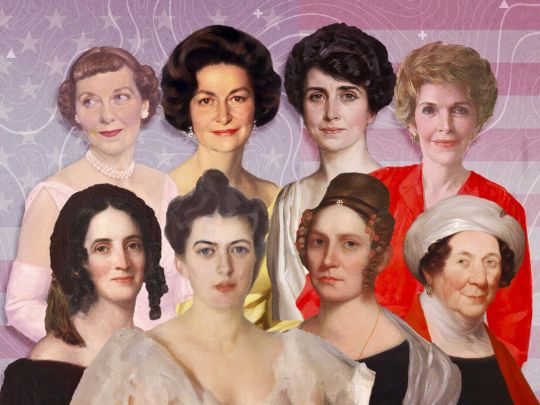
Click this image to view the online exhibition. Depicted clockwise from top left: Mamie Eisenhower, Lady Bird Johnson, Grace Coolidge, Nancy Reagan, Dolley Madison, Abigail Fillmore, Frances Cleveland and Sarah Polk.
(Illustration by Meilan Solly / Photographs via NPG)
Visitors to the National Portrait Gallery’s presidential wing have long called for an exhibition devoted to the U.S.’ first ladies. But as Alicia Ault points out for Smithsonian, these women haven’t always been recognized as important individuals in their own right—a fact reflected in the relative dearth of portraiture depicting them. The gallery itself only began commissioning official portraits of the first ladies in 2006.
“Every Eye Is Upon Me: First Ladies of the United States” seeks to redress this imbalance by presenting 60 portraits—including photographs, drawings, silhouettes, paintings and sculptures—of American presidents’ wives. Though the physical exhibition is currently closed due to the Covid-19 pandemic, would-be visitors can explore a virtual version featuring high-resolution images of first ladies from Martha Washington to Melania Trump, as well as brief biographies, podcasts and blog posts. The portraits are as “varied as the women themselves,” who all responded to the unique challenges and pressures of their office in different ways, writes Ault.
Inspiration for the exhibition’s title comes from Julia Gardiner, who was the first woman to marry a president in office. Born into a wealthy Long Island slaveholding family, Gardiner was just 24 years old when she wed John Tyler in 1844. As Gardiner prepared to take on the high-profile role, she wrote in a letter to her mother that she knew she would be scrutinized: “I very well know every eye is upon me, my dear mother, and I will behave accordingly.”
“Jacob Lawrence: The American Struggle”
Peabody Essex Museum (Salem, Massachusetts)
One of black history’s preeminent visual storytellers, Jacob Lawrence employed Modernist forms and bright colors to narrate the American experience through the eyes of the country’s most marginalized citizens. This year, the Peabody Essex Museum in Salem, Massachusetts, reunited one of Lawrence’s most groundbreaking series—Struggle: From the History of the American People (1954–56)—for the first time in 60 years.
In 30 hardboard panels, each measuring 12 by 16 inches, Lawrence traces American history from the Revolutionary War to 1817, covering such events as the Boston Tea Party and the nation’s bloody, prolonged campaigns against Native Americans, as Amy Crawford wrote for Smithsonian in June. Virtual visitors can stroll through the exhibition, aptly titled “Jacob Lawrence: The American Struggle,” or zoom in on images of each panel. Entries are accompanied by related artworks and reflections from scholars.
When the show traveled to the Metropolitan Museum of Art in New York City, it sparked an exciting reunion. A museum visitor recognized the panels’ distinct Modernist style and realized that her neighbors, a couple living on the Upper West Side, had a similar painting hanging in their living room. Curators determined that the panel, which depicts Shay’s Rebellion, was one of five missing works from the Struggle series. No photographs of the panel had survived, and it had been presumed lost for decades—but as curator Randall Griffey told the New York Times, it turned out to be “just across the park” from the museum.
“Vida Americana: Mexican Muralists Remake American Art, 1925–1945”
Whitney Museum of American Art (New York City)
youtube
When the Mexican Revolution drew to a close in 1920 after ten years of armed struggle, the country was left profoundly changed. But among artists of the post-revolutionary period, a new cultural revolution was just beginning. Over the next several decades, artists like the famed Tres Grandes, or Big Three—José Clemente Orozco, Diego Rivera and David Alfaro Siqueiros—started crafting radical, large-scale works that embraced Mexico’s Indigenous cultures and told epic narratives about the nation’s history.
As “Vida Americana,” an ongoing exhibition at the Whitney Museum of American Art, argues, these sweeping, dynamic murals also had a major impact on Mexico’s neighbors to the north. As Mexican artists traveled to the U.S. (and vice versa), they taught their peers how to break free of European conventions and create public art that celebrated American history and everyday life. On the show’s well-organized online hub, art lovers can explore short documentaries, audio guides, essays and other resources in both Spanish and English. Click through some of the selected artworks from the show to encounter Rivera’s Detroit Institute of Art masterpiece, a massive 27-mural cycle that offered Americans reeling from the Great Depression a visionary outlook of their country’s future industrial potential, and Siqueiros’ experimental workshop, which directly inspired Jackson Pollock’s Abstract Expressionism.
“Dorothea Lange: Words & Pictures”
The Museum of Modern Art (New York City)
youtube
Recognized today as one of America’s foremost photographers, Dorothea Lange is known for her arresting portraits of the human condition and keen social awareness—qualities perhaps best exemplified by her 1936 image Migrant Mother, which became a de facto symbol of the Great Depression.
But few people know that Lange was also enamored with the written word. As she once said, “All photographs—not only those that are so called ‘documentary’… can be fortified by words.” Lange believed that words could clarify and add context to photographs, thereby strengthening their social impact. In her landmark photobook An American Exodus: A Record of Human Erosion, she became one of the first photographers to incorporate her subject’s own words into her captions, as Smithsonian reported in August.
Through this MoMA exhibition’s online hub, viewers can read selections of Lange’s writing, watch a series of short videos on her work, listen to interviews with curator Sarah Meister, and—of course—take their time studying close-up versions of the artist’s iconic photographs.
“Writing the Future: Basquiat and the Hip-Hop Generation”
Museum of Fine Art, Boston (Boston, Massachusetts)
youtube
Jean-Michel Basquiat is often touted as a singular genius. His large-scale works, which riff on color, phrases and iconography to probe issues of colonialism, racism and celebrity, regularly fetch enormous sums at auction.
But the graffiti artist–turned–painter, who died of a heroin overdose at age 27, didn’t develop his artistic vision in a vacuum: Instead, he was profoundly influenced by a network of peers and close collaborators. “Writing the Future: Basquiat and the Hip-Hop Generation,” which opened at the Museum of Fine Arts, Boston, in October, is the first show to consider the influence of Basquiat’s large circle of mainly black and Latino collaborators, all of whom shaped the painter’s artistic vision in 1980s New York City.
The museum complemented its in-person show with a multimedia-heavy online exhibition, which includes detailed essays, images of works in the show and clips of interviews with the artist. Viewers are encouraged to scour lesser-known artworks from Basquiat’s peers, such as the “Gothic futurist” paintings of Rammellzee and the rebellious murals of Lady Pink, in search of themes and styles that Basquiat echoed in his own work.
“Making the Met, 1870–2020”
Metropolitan Museum of Art (New York City)
youtube
A group of businessmen and civic leaders purchased the Metropolitan Museum of Art’s first work—a marble sarcophagus from ancient Rome—in 1870. Since then, the museum’s collections have become some of the greatest troves of cultural heritage in the world, constituting an encyclopedic range of artifacts that attracts millions of visitors each year.
This year, the Manhattan museum celebrated its 150th birthday by hosting a celebratory exhibition and slate of virtual offerings: Among others, the list of digital resources includes an hour-long audio tour of some of the exhibition’s highlights, as narrated by actor Steve Martin; an interactive online version of the show; and a virtual walkthrough courtesy of Google Arts and Culture. Met officials also made a rare gem available for public viewing: Behind the Scenes: The Working Side of the Museum, a silent 1928 documentary that depicts curators and janitors at work in the iconic New York building.
“The Museum of the World”
The British Museum (London, England)

Click this image to access the interactive timeline.
(Screenshot via British Museum / Google Arts & Culture)
An innovative example of the possibilities of online exhibitions, the British Museum’s “Museum of the World” debuted in February 2020—and it couldn’t have been better timed. Though the museum remained closed to in-person visitors for much of the year, desktop computer users were able to use this interactive timeline to visualize connections between different items in the museum’s vast collections.
On the website, which the museum developed in partnership with Google Arts & Culture, viewers can trace links through time and space, jumping from a handscroll describing courtly behavior of ladies in the Eastern Jin Dynasty of China to the jade plaque of a Maya king. With a slick interface and audio elements, the timeline encourages viewers to take an interactive, self-directed trip through the material culture of human history.
Notably absent from the project is an acknowledgement of the London museum’s colonialist history, which came under renewed scrutiny this summer amid global protests against systemic racism. In August, the cultural institution moved a bust of its founder, who profited from the enslavement of people in Jamaica, to a new display featuring added contextualization. As Aditya Iyer writes for Hyperallergic, the museum recently made a “promising but flawed start [at] grappling with” this legacy by curating a self-guided tour titled “Empire and Collecting.” Available online in an abbreviated format, the tour traces the “different, complex and sometimes controversial journeys of objects” that entered the collections, according to the museum’s website.
“The Night Watch”
The Rijksmuseum (Amsterdam, the Netherlands)
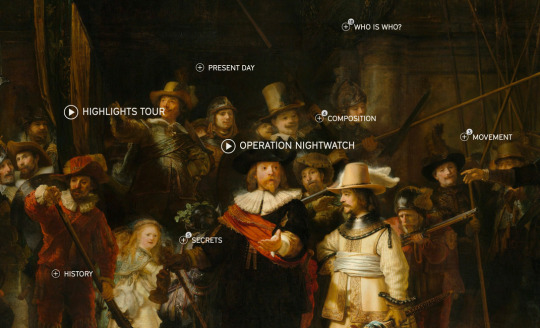
Click this image to access the interactive portal.
(Screenshot via the Rijksmuseum)
In this new hyper-resolution view of Rembrandt van Rijn’s The Night Watch, art lovers can pore over every detail of the Dutch master’s most famous painting—down to every crack and stray paint splatter, as Theresa Machemer wrote for Smithsonian in May. The Rijksmuseum in Amsterdam debuted the interactive version of its prized painting as part of a lengthy restoration process dubbed Operation Night Watch. Last year, experts began restoring the 11- by 15-foot painting in a glass chamber installed in the middle of the museum, offering visitors a rare behind-the-scenes glimpse at the conservation process.
Officially titled Night Watch, Militia Company of District II under the Command of Captain Frans Banninck Cocq, the 1642 painting depicts a captain instructing a cadre of soldiers. In the online guided tour (which comes with options for children and adults), users can zoom in on different aspects of the painting while a soundscape—the swish of a cloak, a horse’s hooves, an eerie melody, a far-off bell—sets the mood. Look for Rembrandt’s signature, his presumed self-portrait lurking in the painting’s background, the striking young girl with a chicken dangling from her belt and other mysterious elements embedded in the action-packed scene.
According to a statement, the image combines 528 exposures into one composite, making it the most detailed rendering of Rembrandt’s masterpiece ever created. The project is a prime example of how online galleries can encourage viewers to engage in repeated, close study of the same piece of art—and proof that they can always discover something new.
“Van Eyck: An Optical Revolution”
Museum of Fine Arts Ghent (Ghent, Belgium)

Click this image to access the virtual experience.
(Screenshot via Museum of Fine Arts Ghent)
Curators and art enthusiasts were crushed when the pandemic forced a blockbuster Jan van Eyck exhibition at the Museum of Fine Arts in Ghent to close less than two months after opening. The once-in-a-generation show—titled “Van Eyck: An Optical Revolution”—represented the largest-ever display of van Eyck’s paintings and was “so unlikely to be repeated that the museum might as well use ’now or never,’” as J.S. Marcus wrote for the Wall Street Journal in January.
In response to the unexpected closure, the museum pivoted, partnering with Belgian virtual reality company Poppr to create a 360-degree tour of the gallery with accompanying audio guides for adults and children. Star items featured in the show included Portrait of a Man (Léal Souvenir) and panels from the spectacular Ghent Altarpiece, whose center panel depicts Jesus as a sacrificial lamb on an altar, alive but bleeding from a wound. Prior to the exhibition, the panels had not left their home in St. Bavo’s Cathedral since 1945, as Sophie Haigney reported for the New York Times earlier this year.
Born in 1390 in what is now Belgium, van Eyck created spectacularly detailed oil paintings of religious scenes. As the show’s website notes, only about 20 of the Flemish master’s paintings survive today.
“Wise and Valiant: Women and Writing in the Golden Age of Spain”
Instituto Cervantes (Madrid, Spain)

Click this image to browse the exhibition’s essays and artworks online.
(Screenshot via Instituto Cervantes)
Spain’s Golden Age is perhaps best known for producing Miguel Cervantes’ Don Quixote, El Greco’s eerily elongated portraits and Lope de Vega’s prolific plays. But as the now-closed exhibition “Wise and Valiant” showed, these individuals and their male peers weren’t the only creative geniuses at work during the 16th and 17th centuries. Though women’s opportunities at the time were largely limited to the domestic and religious spheres, a select few took advantage of the relative intellectual freedom offered by life in a convent to pursue writing professionally.
From Mexican nun Sor Juana Inés de la Cruz to playwright Ana Caro and nun-turned-soldier Catalina de Erauso, hundreds of women across the Spanish Empire published poetry, diaries, novels, dramatic works and travelogues. Though many of these works have since been lost or forgotten, scholars are increasingly taking steps to recover their authors’ hidden stories—a trend reflected in the Madrid show, which explored women writers’ lives through a display of more than 40 documents. As Lauren Moya Ford observed in Hyperallergic’s review of the show, the online version of the exhibition (available in both Spanish and English) presents their stories in a “format well-suited to this dense, delicate material.” Users can delve into digitized historical documents, browse curator commentary and watch a video montage of relevant clips.
#History
2 notes
·
View notes
Photo

HELEN FRANKENTHALER
The Bay
1963
acrylic on canvas
“At first glance, it’s hard to know what to make of Helen Frankenthaler’s heaving, atmospheric painting, The Bay.
We see an imposing fluid blue promontory suspended in front of us. Its colors ranging from violet to indigo run into one another with a clear zone of navy near the top of the canvas that draw our eyes up to it. The blurring of the colors gives an immediate sense of the artist’s process: paint poured onto the canvas when it was wet. We can almost watch as the blues meld into one another during this early stage giving the image its blurred and smooth finish.
Is its subject what the title suggests—a landform of some kind with certain emblematic associations? Is the swelling amorphous blue mass floating amid that moss green and cream border meant to stand for something beyond itself?With many Abstract Expressionist paintings of the 1950s and 60s, it’s important not to get too caught up with possible social and historical contexts and biography, but to focus on what’s before us—the physical elements of the work itself because those elements can tell us so much about the painting.
When Helen Frankenthaler painted The Bay, she was already a well-regarded artist. She’d been the subject of a LIFE Magazine profile in 1956 and was one of the handful of women among the traditional all-boys’ club of the New York Abstract Expressionists. The Bay was chosen as one of the paintings for the American pavilion of the 1966 Venice Biennale. Looking closely you can see that the shades of blues that run into one another are part of a specific process of pouring paint on to the canvas rather than painting the colors onto the surface with a brush, as the leading Abstract Expressionist painters, like Jackson Pollock, Willem de Kooning, and Franz Kline, were so famous for doing.”
– Helen Frankenthaler, The Bay by FARISA KHALID
1 note
·
View note
Photo






Environmental portrait research
Task 1 Pre-Production: Inspiration
5. Arnold Newman
This is undoubtedly the most famous environmental portrait photographer, and my main influence for this project. I really admire his work. I think the way he portraits people is astonishing. He’s the pioneer of the ‘environmental portrait’ genre. He photographed a lot of celebrities but not only.
The portrait of Stravinsky is possibly his most famous photo due to an interesting/unusual crop. I think it defined a lot of his work. I like the way he cropped and sacrificed parts of his photos to truly direct the viewer’s eye in the right direction/his direction.
The other really famous one is the portrait of the former Nazi industrialist Alfried Krupp who’s shown as menacing due to the composition and use of light in the photo.
Newman says ‘a portrait is a form of a biography. Its purpose is to inform now and to record for history.’
I’m trying to remember that when I photograph people, that it’s just a moment frozen in time, it will never be the same ever again, it’s a testimony of something that has already passed. The photo of Jackson Pollock shows that and it inspired me a lot for my project as I am going to show the work of a painter. You want to portrait something or someone in an environment, but time really defines everything. I like that it’s so unique and could be different if done even a few hours earlier/later.
The photo of Cocteau reminds me of the one of Philip Glass, the main light being on the work or the tools, and not the actual person. It’s a really nice portrait also showing Paris on the background. You can imagine it’s in a tiny apartment.
Finally the one of Bill Clinton shows the busy side of being a president. It almost looks like he’s about to leave because he doesn’t have time for a photograph, although he seems to be playing the game by smiling and staying quite still. I like the body language in this one because it’s a little bit ambiguous, you’re not quite sure whether he poses or if he’s truly comfortable.
1 note
·
View note
Text

hello, its nora (she/her, gmt) n this is the ethereal but spoiled alma olive putnam (she goes by all 3 names cos she’s pretentious as fuck). raised in a farmhouse in vermont, big horse girl energy. very hungry for everything life has to offer. wakes up and smells the success in her blood. luvs the smell of libraries and listening to french music from a tinny record player in knee socks. here is pinterest. bio is below the cut, like this post to be bombarded with plotting messages but i might forget tho so pls message me x
application template.
『ELLE FANNING ❙ CIS-FEMALE』 ⟿ looks like ALMA OLIVE PUTNAM is here for HER JUNIOR year as a CLASSICS student. SHE is 21 years old & known to be RESILIENT, MAGNETIC, CALLOUS & PROUD. They’re living in PERKINS, so if you’re there, watch out for them. ⬳ NORA. 24. GMT. SHE/HER.
aesthetics.
a red beret nestled on top of bright platimum locks, neck scarves tied around your throat the way they do it in french new wave films, running barefoot through the woods in feckless hedonism, china dolls with porcelain faces lined against the walls of your room, the mona lisa smile, knee-socks tugged over the hockey grazes on your knees, a forged botticelli drying on your easel, ophelia floating in the middle of a lake.
proceed w caution, tw for death, drugs, alcohol, violence
the short form.
— studying classics cos she thinks it makes her sound smart, but actually hates fuckin latin and just loves learning about feckless hedonism and the festivals of bacchus and writing about how all women in myth are literally forgotten. was expelled from princeton in her first year so her parents basically paid her way into radcliffe but she made an impression.... like... super fast and in her sophomore year she was upgraded to perkins accomodation n a paid scholarship bcos i think the governors kind of expect to see her in the supreme court one day or.
— born in vermont in a big old farmhouse. her great-great-grandfather moved to america as an immigrant and worked on a plantation, made his way up cos he could speak a lot of languages and therefore win more people over. for the last two generations, putnam men have owned the farm and do little of the dirty work. big in the meat industry.
— both her parents had large personalities, so alma’s never really been shy around adults, even as a kid she’d speak to them in a forthright, confident manner, and because she was always surrounded by adults, she’s always seemed a bit wise beyond her years.
— very much a consolidation of every character in the secret history. has a morbid longing for the picturesque at all costs. obsessed with w.h. auden and the beat poets.
— ”aestheticism is the only thing worth pursuing and even that is pointless”
— is majoring in classical civilisation. can read ancient greek and latin. also speaks french.
— studies hard and plays hard. she gets top marks but it’s because academia is literally her life, she loves the smell of libraries, the ancient smoke of learning, of feeling like old wine in a new bottle reincarnated from the bones of some old, dead witchy woman who invented a cure for cowpox or somethin.
— isn’t a foward-planner, however. alma prefers to leave her options open, play the field, live in a spontaneous manner so her study style is mostly cramming a few days before a test, or staying up all night writing an essay on a massive adrenaline boost powered by red bull or probably adderall, scribbling (or typing) furiously into the night.
— pretentious motherfucker. loves poetry, especially the romantics, loves morbid ones too, edgar allen poe, sylvia plath, allen ginsberg, she just loves them all. can’t get enough. her favourite films are like…. wanky artfilm independent european cinema. especially french new wave. “what do you think of goddard’s work??” while snorting a line off someone’s sink at 5am on a school night, but you can bet she’ll make it to that 9am class.
— very intelligent and beautiful and knows both of those facts. plays devil’s advocate. humanitarian, vegan.
— judgemental but takes great care not to appear so. petty and vindictive
— obsessively devours mystery and thriller novels. she herself is a gillian flynn book waiting to happen.
— tries to be an enigma. wants to be mysterious and unreadable because that’s what books have taught her makes women desirable and interesting and cool. very amy dunne in the way she expertly reinvents herself to suit her audience, when she wants to impress
— act like the flower but be the serpent under it. is a user. manipulative. leads people on. will throw another student under the bus to demonstrate her own intelligence and integrity
— heavily involved in the theatre society. loves attention.
— has an addictive personality. seems unable to do anything in a small dose, she has to let it utterly consume her. with sports, she’s fiercely competitive, runs track, played lacrosse at school, now is a cheerleader probably. with alcohol, it’s never a shot, it’s a whole bottle – wine or whiskey – she’ll be table dancing before the night’s up and making out with someone she’ll regret in the morning.
— her clothing style is like…. vintage thrift store but make it preppy. berets and cute hats, neck scarves, large fluffy cardigans or like those leathery jackets with big suede fringes on them, mini skirts (very 70s), and knee-high socks or boots. quite often she’ll be in sports kit, maybe a cute tennis skirt, n when she’s feeling casual she’ll wear like, a talking heads tshirt with a pair of mom jeans and converse, but otherwise, the library is her catwalk.
— relates to ophelia from hamlet and sibyl vane in dorian gray. weirdly obsessed with women who commit suicide. loves jackson pollock paintings and abstract art.
– likes old things. old books, old music, old houses, it reminds her of happier times like when she wasn’t alive. buys all her music on vinyl and has a gramophone because “the sound quality is better” kfdsjj.
plots.
here are some generic wanted plots but by all means message me so we can flesh them out more if any strike ur interest:
study buddies !! someone who is equally unprepared and so spends all night in the library with alma before a big deadline, maybe they even met in the library
if they’re from new england or vermont, then cousins . second cousins / extended family / family friends – probably spat volavons on your character once as children, omg childhood friends !
people who live in perkins n feel like they r constantly competing with one another to keep their place as one of the #elite only know each other from brief interactions in the lift or the canteen
honestly someone who is fully in love with her or crushing on her that she can just break would be sweet :/ or on the other hand someone she unexpectedly gets feelings for and actually wants to guage her own eyeballs out bc of it
frinds !! unlikely friends !! toxic friends !! former best friends separated by sporting or academic rivalries !
hockey / cheer friends who are on other teams but who she absolutely loves playin against!!!
fellow academics who like meeting up to discuss latin and greek ! gimme a secret society bonding by their love of ancient learning
i reckon she’s in a lot of societies, definitely the film club, maybe works as a projectionist at the uni cinema if they have one so give me ppl affiliated with that, give me fellow wanky pretentious art-lovers and poets and historians who will go to museums and galleries with her and listen to the velvet underground on vinyl
people she gets mortally fucked off her tits with at parties
people who think she is throwing her academic potential away by caving to hedonistic impulse
A SECRET SOCIETY !!! honestly i would die for a slug club esque thing in which the children of notable families are invited to dinners OR alma’s also an art forger, so maybe like a club of students set up to basically forge paintings and documents from the university special collections
people she has drunkenly made out with, hooked up with, or regularly sleeps with casually, maybe even a friend w benefits she is repressing feelings for, i love angst,
people she used to date or unrequitedly likes, but to them it’s just a physical thing, give me all the thirsty angst plots, and maybe some softness too, i need some religion in this girls life, she is a roman catholic after all
full biography.
alma olive putnam.
intro.
the girl is a knife. razor-sharp, double-edged, the bright shine of a two-faced, lovely thing. silver like the secrets you magpie thief from other heads. you’re a scavenger of knowledge, of tidbits, of gossip to lock away for later use and late-night re-inspection. a mind is like a clock if you get to learn the pieces. bit by bit, you dismantle the inner workings of the brains that tick around you – how easy it is to change it’s path, how words and their meanings can make a person laugh or cry in an instant. to have the power to control that is to be a god. it’s the power trip you crave wielding pom-poms in your hands; a possessive need for control that a younger you, small and weak, never had as a child. small lips, smaller smile, a doll clutched in your too-hungry fingers, hard enough to shatter the bones of a real infant. you cut your hair with your mother’s kitchen scissors before the autumn falls, rendering you out of season, unfit for the cold weather that beats against the nape of your neck, where a stick-and-poke marks the star you were born under ; the bull. “mama, when will i be a queen?” as soon as they find a crown small enough not to slip from your head.
biography.
if you get hungry enough, they say, you start eating your own heart. hands red, stained by pomegranate seeds, the empty pulp of its shell splattered on your thighs you find yourself wondering – what would it be like to want? in the beginning, you never knew hunger. twins, born under the same star, you first, him second – a nuclear family. never a sister to compete with, you were always the cherry pie of your parents’ hearts. white-haired, blue-eyed, beautiful baby of mine. the townhouse in vermont and the summer house in lyon, you wanted for nought, showered with attention, saddled with gifts - hardly a wonder you came to rely on such affection as a confirmation of your own worth.
at eight years old you first met death, blood on a gingham-print dress, a smear of it over your cheekbone and the pulp of a mangled animal at your feet murdered by the hands of a stable boy. “alma, my precious baby, you get away from that filth,” your mama would cry from the upstairs balcony – cigar in one hand and a bloody mary in the other – though whether the filth she referred to was the dead pig or the boy with a kernel of corn in his mouth, you never did find out.
your family earned their keeps in farming, great-grandfather wolfgang hildegarde a german immigrant, great-grandmother maura lisbon a prairie girl. they fell hopelessly in love between troughs and pig-shit, working for three dollars a day at a farm their descendants would later own, trade deals with the indians, vacations to calcutta, your father todd putnam in the kind of sheepskin coat his father’s father could only dream of owning. he worked hard so that you’d never have to. your mama once asked – you heard it through the window, rounding cartwheels across the picket-fenced lawn – could he not find a respectable career rather than selling shrink-wrapped pork for a dime a dozen? that blood money had no business raising a child. you look far back enough, edie, your father had said in his low, strong voice that could bring a civil war to silence, and i think you’ll find that all money is blood money.
language was never fickle on your tongue, french dinner time talk by the time you were out of your hush puppy shoes, your mama fixing the au pair a smile as she fixed herself another martini. you learned the clarinet at four and how to dance with the grace of a swansong at six, ethereal under a spotlight, an audience captive in the palm of your hand. by eight you knew that you’d always been destined to be loved. loved so hard they would want to taste you, bite into the soft plump of your cheek and eat you alive. that was how magnetic you wanted to feel. but mother hamsters eat their own young when penned in together too long, and soon you became too wild, too restless, another package on your father’s delivery invoice, box-shipped out to english boarding school.
fitting in had never been something you had to concern yourself with. you were always the shiny new toy the other girls wanted to play with, bright like a dropped coin from a magpie’s beak. wherever you went, you seemed to leave a trail of awe, pig-tailed harriet’s adoring you, imitating you, teachers forgiving your class-time chatter for the sake of your wild heart and the restless spirit you possessed. tell us what it’s like in the states, alma. they’d coo, enamoured by your hollywood drawl. does your father own a gun? you hardly knew. barely even knew the colour of his hair, for the scarce amount of times he’d stoop to kiss your cheek, though you’d tell silver-tongued tales if it’d guaranteed you an audience. when you learned how to smile at the right times, and that flattery would get you everywhere, it soon became apparent that charm would pave the yellow brick road to success even when your lack of drive couldn’t.
the road you followed – gum-snapping, roller-blading, friendship bands all up your arm – eventually led you to radcliffe. bright-eyed and gingham skirted, you’d always known you were more. there was a hunger in you to be something extraordinary, a want so adamant to be imagined and desired that it was almost savage. in leather-bound volumes and a circle of stones, you were helen of troy, the girl for whom they’d launch a thousand ships. but there’s so much rage within you, collecting like sawdust in cavernous parts. hockey helped. there was something grounding about the feeling of a stick clasped in your hands. sweat. stiff knuckles. feet pounding the earth. the smash of wood against flesh in the scram of a game, passed off as mere enthusiasm. “slipped, sorry.” hockey is the one thing you had that was yours alone – a feral instinct that motivates you to play; something primitive within you that sparks an energy like no other. on the pitch, you feel alive. you feel like a god.
15 notes
·
View notes
Text
Forever Art Mooching
Some of the Fab art I’ve seen in Mayfair galleries these last couple of weeks:

James Turrell
At Pace Gallery until March 27 2020
From the PRESS RELEASE: James Turrell’s recent Constellation works, the focal point of this exhibition, are the culmination of Turrell's lifelong pursuit. Generating what the artist has called “spaces within space,” these luminous portals are instruments for altering our perception; gazing into them results in the slow dissolution of the boundaries of the surrounding room, enveloping the viewer in the radiance of pure color. Fusing the temporal, sensuous, and illusory qualities of his projection works and architectural installations, the Constellations synthesize several aspects of Turrell’s practice. Unlike his early projection pieces, however, they are not about generating an illusion; instead, they greet the viewer with the actual materiality of light, what Turrell calls “the physical manifestation of light, which we have trained our eyes too readily to look through rather than to look at.”
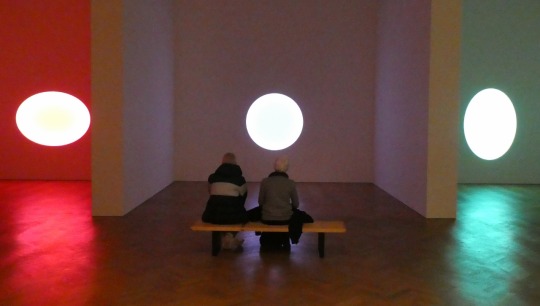




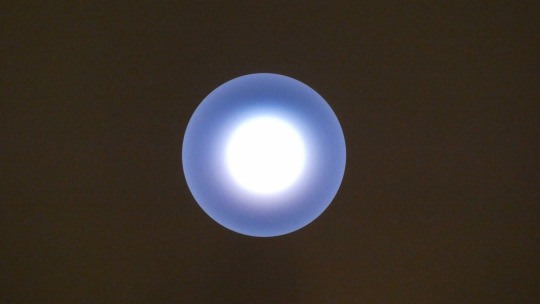
Monochrome 2
At Ordovas Gallery until 25 April 2020

Dan Flavin’s Untitled (for Charlotte and Jim Brooks) 4 (1964)
From THE PRESS RELEASE:Monochrome No.2 focuses on a selection of blue works by nine contemporary European and American artists as they contemplate the colour’s complex associations and aesthetic possibilities through a variety of media. The myriad hues that make up this enigmatic colour evoke the elemental as well as the emotional, tint our memories, and are apt, according to Goethe, ‘to disturb rather than enliven’. From an intimate blue ballpoint pen drawing made by Jackson Pollock in the late 1930s to a specially commissioned neon work by Joseph Kosuth, the exhibition touches upon the depth and diversity of blue, prized throughout the ages as the rarest and most mysterious of colours.
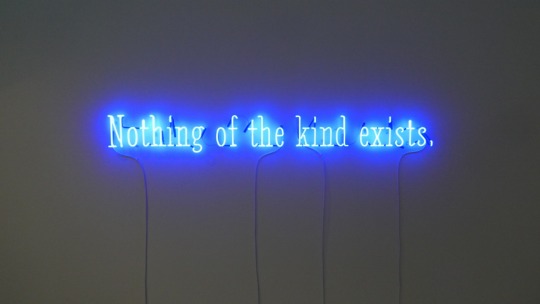
Joseph Kosuth - Nineteen Eighty-four(Orwell) #4 (2019)

Jackson Pollock - Untitled Pen, blue ink and brown crayon on paper c1939-42

Installation shot

Installation shot showing Roy Lichtenstein Seductive Girl (study) 1996
Yves Klein - La Marseillaise (ANT138) 1960
Cy Twombly - Untitled sculpture 2005
Felix Gonzalez-Torres - Untitled (loverboy) Blue paper, endless supply 1990
Heaven And Hell Are Just One Breath Away
Andy Warhol at S2 until 28 February
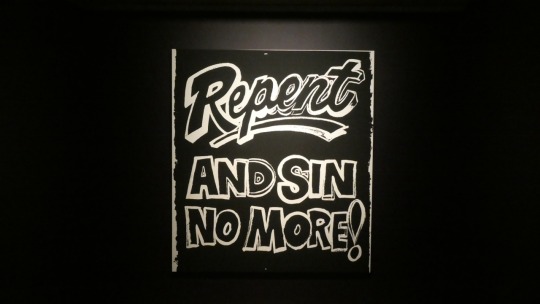
1985-86
From THE PRESS RELEASE: S|2 London presents a spotlight on the last cycle of paintings by Andy Warhol. Warhol was raised in a devout Byzantine Catholic household in Pittsburgh and was found to have retained a personal commitment to his faith throughout his life. Alongside his interest in consumer culture and celebrity, Warhol also explored religion and mortality within his practice, particularly towards the end of his career. The exhibition at S|2 will include works from this late period, including examples from Warhol’s 1986 Last Supper series, his iconographic crosses and skull, as well as his appropriations of religious pamphlets and slogans such as the prophetic Heaven and Hell Are Just One Breath Away! that became one of his final works.

Crosses 1982
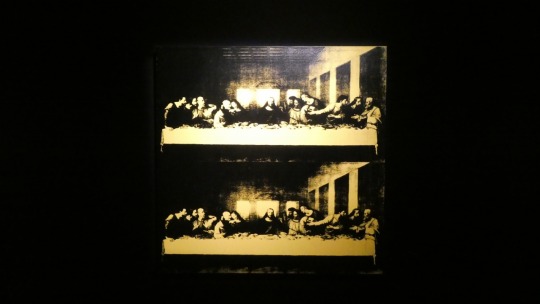
The last supper 1985-86

The Last Supper 1986
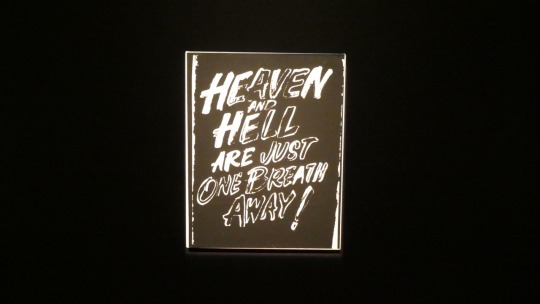
1985-86

Christ $9.98 (Positive) 1985-86
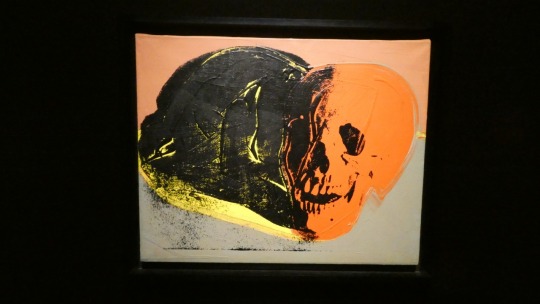
Skull 1976
A line Can Go Anywhere
Ruth Asawa at David Zwirner to 22 February 2020
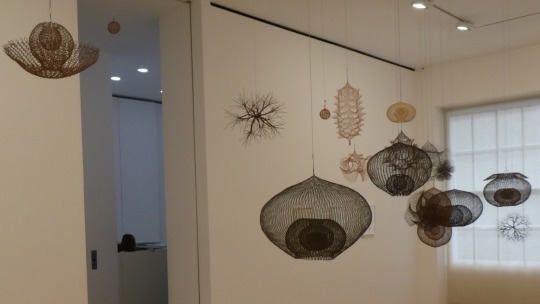
From THE PRESS RELEASE: This will be the first major presentation of the artist’s work outside of the United States and will include a number of her key forms, focusing in particular on the relationship between her wire sculptures and wide-ranging body of works on paper.
An influential artist, devoted activist, and tireless advocate for arts education, Asawa is best known for her extensive body of hanging wire sculptures. These intricate, dynamic, and sinuous works, begun in the late 1940s, continue to challenge conventional notions of sculpture through their emphasis on lightness and transparency. Relentlessly experimental across a range of mediums, Asawa also produced numerous drawings and prints that, like her wire sculptures, are built on simple, repeated gestures that accumulate into complex compositions. Although she moved between abstract and figurative registers in her sculptures and drawings, respectively, viewed together, the works in this exhibition nevertheless incite a rich dialogue and find commonality in their sustained emphasis on the natural world and its forms, as well as in their deft use of the basic aesthetic concept of the line. As she noted, “I was interested in it because of the economy of a line, making something in space, enclosing it without blocking it out. It’s still transparent. I realized that if I was going to make these forms, which interlock and interweave, it can only be done with a line because a line can go anywhere.”1
Born in rural California, Asawa was first exposed to professional artists while her family and other Japanese Americans were detained at Santa Anita, California, in 1942. Following her release from an internment camp in Rohwer, Arkansas, eighteen months later, she enrolled in 1943 in Milwaukee State Teachers College. Unable to receive her degree due to continued hostility against Japanese Americans, Asawa left Milwaukee in 1946 to study at Black Mountain College in North Carolina, then known for its progressive pedagogical methods and avant-garde aesthetic environment. Asawa’s time at Black Mountain proved formative in her development as an artist, and she was particularly influenced by her teachers Josef Albers, Buckminster Fuller, and the mathematician Max Dehn. She also met architectural student Albert Lanier, whom she would marry in 1949 and with whom she would raise a large family and build a career in San Francisco. Asawa continued to produce art steadily over the course of more than a half century, creating a cohesive body of sculptures and works on paper that, in their innovative use of material and form, deftly synthesizes a wide range of aesthetic preoccupations at the heart of twentieth-century abstraction.
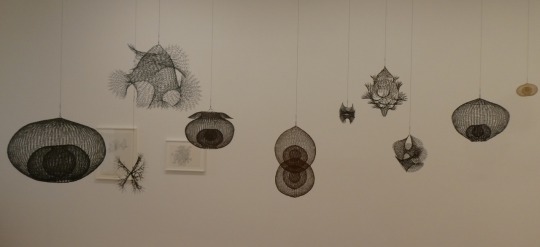


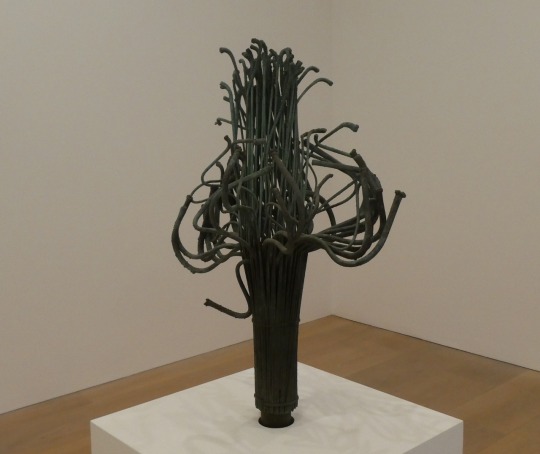

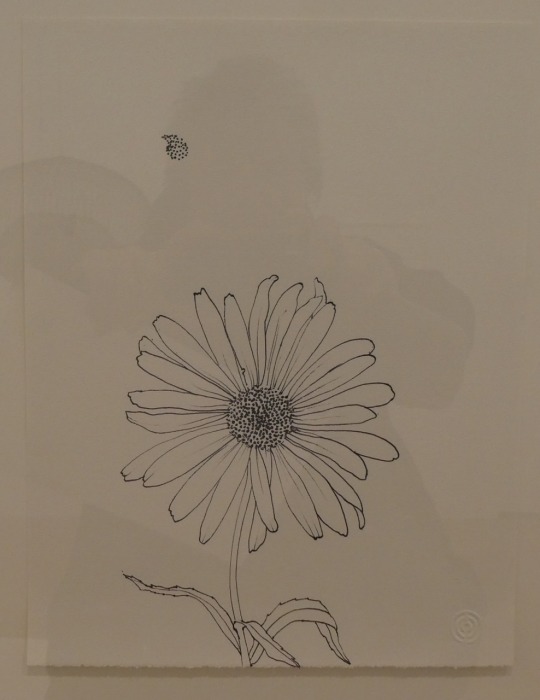
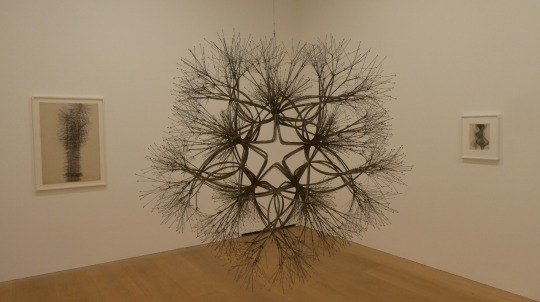

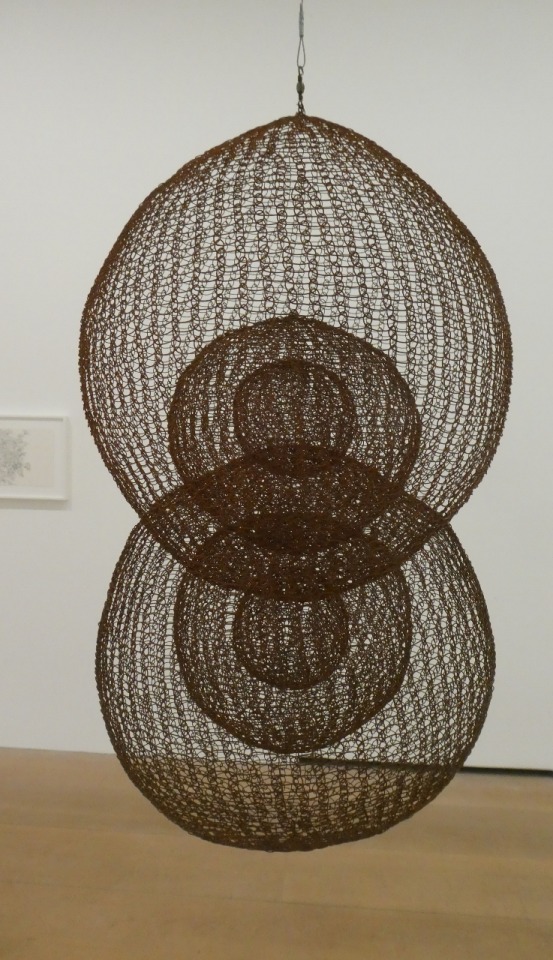
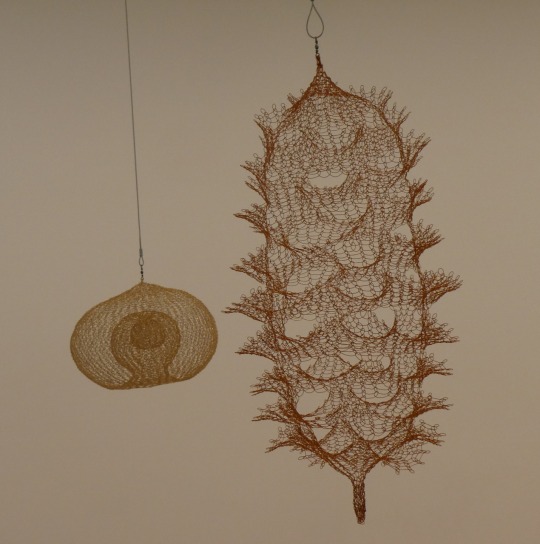

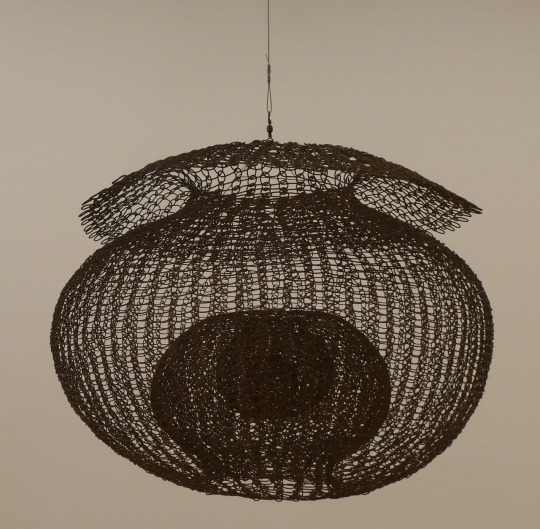

Work on paper at The Black Mountain College using BMC laundry stamp
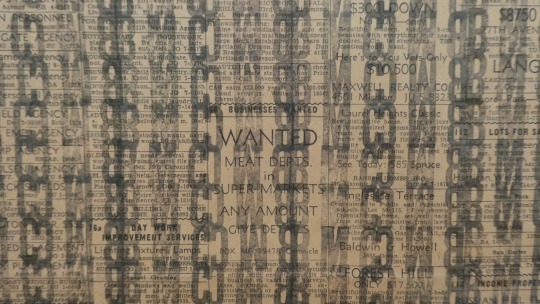
detail
“It doesn’t bother me. Whether it’s a craft or whether it’s art. That is a definition that people put on things. And what I like is the material is irrelevant. It’s just that that happens to be material that I use. And I think that is important. That you take an ordinary material like wire and... you give it a new definition. That’s all.” —Ruth Asawa 2002
After Sight
Benode Behari Mukherjee
at David Zwirner until 22 February 2020
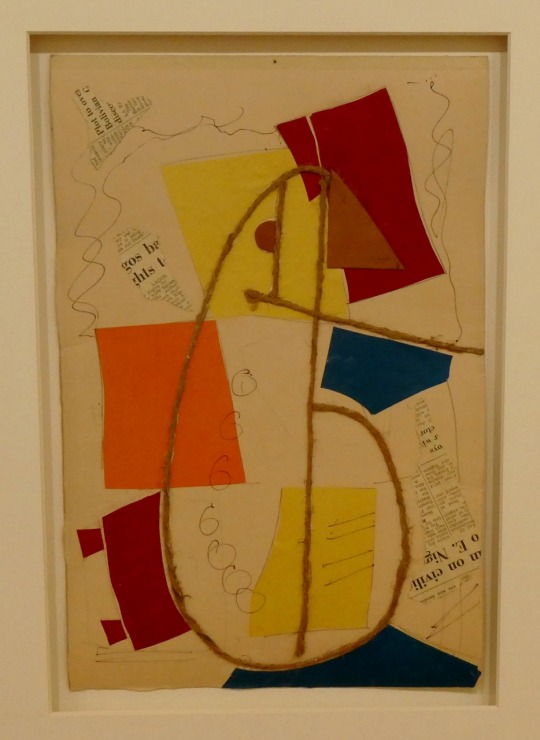
From THE PRESS RELEASE: The first solo presentation in Europe devoted to Mukherjee, the exhibition will focus on the artist’s collages from the late 1950s and 1960s, after he lost his sight.
A pioneering Indian modernist, Mukherjee blended imagery and iconography from Indian life with a signature visual style influenced by Indian, East Asian, and Western art practices and traditions. Mukherjee studied with the celebrated artist Nandalal Bose as one of the first students at the renowned Kala Bhavana, the fine-arts institute founded by the poet Rabindranath Tagore at Visva-Bharati University in Santiniketan, West Bengal. The curriculum of Kala Bhavana was structured similarly to that of the German Bauhaus (Tagore travelled to Europe often, and he visited the Weimar Bauhaus in 1921), with students encouraged to explore form and style in an open manner with various mentors. Rather than depicting mythological or nationalistic imagery, common themes and subjects among Indian artists at this time, Mukherjee examined nature and his immediate surroundings. He created works in a variety of media, from graphite drawings to wall frescoes, all of which exhibit a deeply modernist yet highly individualistic and contextually specific sensibility towards form, color, and composition. As art historian Juliet Reynolds writes: ‘[Mukherjee’s] attempt… was to reconcile Indian folk and classical art with far-eastern calligraphic painting, European early-Renaissance conventions and modern idioms.’

Cat 1965

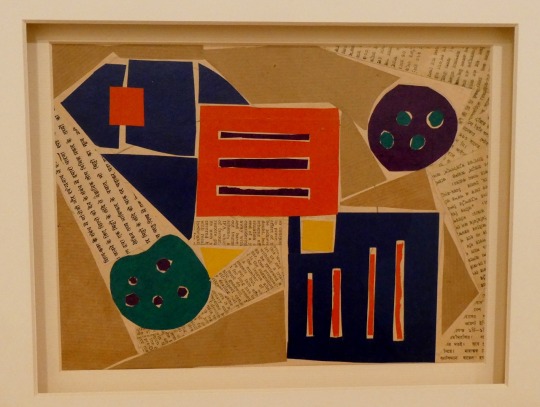
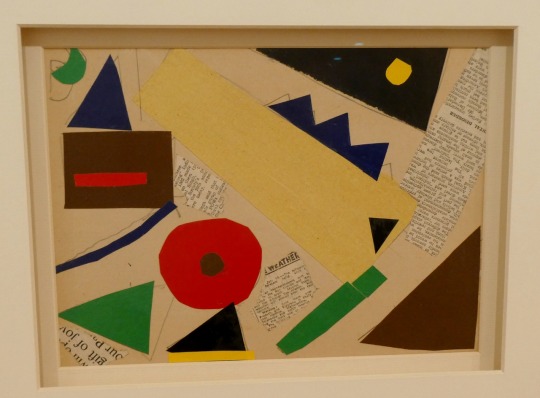
To Exalt the Empheral
Alina Szapocznikow, 1962 – 1972
at Hauser & Wirth to 2 May 2020
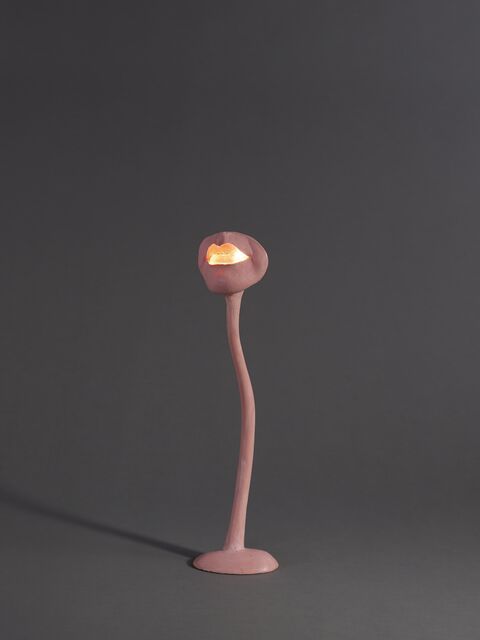
From THE PRESS RELEASE: In a brief but explosively inventive career, Alina Szapocznikow (1926 – 1973) radically re-conceptualised sculpture as a vehicle for exploring, liberating and declaring bodily experience. ‘To Exalt the Ephemeral: Alina Szapocznikow, 1962 – 1972,’ reveals the full expressive potential of this pioneering Polish artist’s work through the material innovations she made during the last decade of her life and is the first solo presentation of Szapocznikow’s work in the UK since her acclaimed exhibition at The Hepworth Wakefield in 2017.
The details of Szapocznikow’s biography have been well documented and readings of her work have often emphasised her experiences. Born in Poland to a Jewish family in 1926, she survived the horrors of concentration camps as a teenager. In the post-war years, moving from Prague to Paris, she ultimately abandoned the Socialist Realism endorsed by the Polish government, as well as the prevailing winds of modernist abstraction, to embrace Surrealist tendencies and the Pop-influenced New Realism of the Paris avant-garde, championed by Pierre Restany. Working furiously as she cycled through phases of artistic growth, Szapocznikow engaged themes related to the body with full intensity. In the last decade of her life, her experimentation with new materials acquired particular focus and force, yielding works that dramatically challenged the traditional language of sculpture and presaged approaches central to art today. Her work and life were cut short in 1973 when, at the age of 46, she succumbed to cancer.
‘To Exalt the Ephemeral’ begins with one of Szapocznikow’s pivotal works, made in 1962. ‘Noga (Leg),’ a plaster cast of the artist’s right leg, marks her shift away from the mere representation of the human body to a tangible imprint of her own personhood. Here, a single limb, detached from the larger structure that has defined it, becomes a symbol of individuation and a vehicle of pleasure, while nodding to the mechanical forces that commodify the female body.
Building on the idea of reproduction, Szapocznikow experimented with new industrial materials, including polyester resin and poured polyurethane foam. As the artist explained, ‘Plastic materials seem perfect to me for attempts to express and capture our age because of their repetitive possibilities, their lightness, their colours, their transparency, their inexpensiveness. The age of modular multiplication, of swift mass consumption, of automatic repetition. These symptoms that are so characteristic, so superficially gay and so sadly monotone and moving. I hope to be able to explore deeply the problem of the repeated module, in direct contact with the module’s industrial reproduction.’
Themes of mortality and violence have been a point of focus in the reception of the work, yet Szapocznikow equally mined the erotic and the absurd as terrains of investigation.

Through her material experiments, Szapocznikow generated a series of lamps, exemplified here by the ‘Lampe Bouche (Illuminated Lips)’ (1966) works, functional sculptures of glowing female lips extending from elongated stem-like bases. ‘Sculpture Lampe (Sculpture Lampe)’ (1970) combines a phallus-like form with a breast, the fragmented and juxtaposed body parts implying fetish objects. Although the artist lived and worked in Paris at the time, her focus on malleable material as a proxy for the body firmly positions her among contemporaries practicing in the United States, including Eva Hesse, Hannah Wilke, and Lynda Benglis, as well as noted friend Louise Bourgeois, to whom Szapocznikow dedicated and gifted two lamp sculptures similar to those on view.
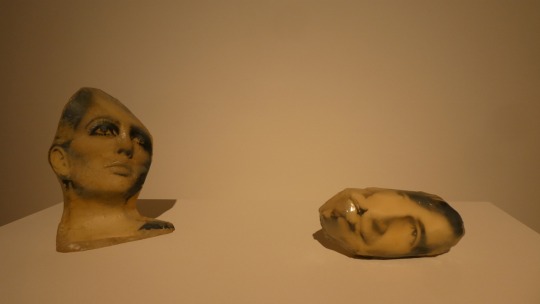
Souvenirs (Polyester resin and photographs) 1967
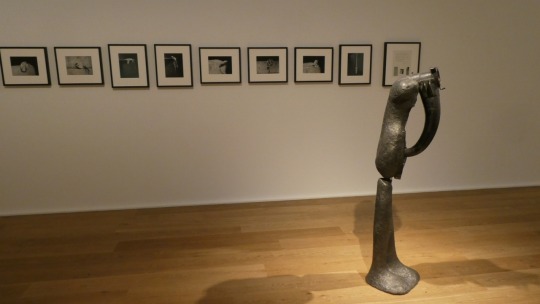
Man with Instrument 1965
Window
Isa Genzken at Hauser & Wirth to 2 May 2020

From THE PRESS RELEASE: ‘Window’ is an exhibition at our London gallery by Isa Genzken featuring a new and unseen body of work. Genzken’s immersive environment expands on the themes of travel, through elements of an aircraft cabin, and the window as a juncture between interior and exterior spaces. In this respect, it reveals the artist’s interest in architecture and light, a topic of enduring resonance in her work as seen in the landmark exhibition in Chicago in 1992, ‘Everybody Needs at Least One Window’.
Isa Genzken has long been considered one of Germany’s most important and influential contemporary artists. Since the 1970s, Genzken’s multifaceted practice has encompassed sculpture, photography, found-object installation, film, drawing and painting. Her work borrows from the aesthetics of Minimalism, punk culture and assemblage art to confront the conditions of human experience in contemporary society and the uneasy social climate of capitalism. Throughout her fifty-year career, Genzken’s primary focus has always been sculpture, and although her style has remained varied, her work has maintained a striking common thread and internal truth to both her vision and to the works of art themselves.
Love, By Any Means Necessary
Kendell Greers at Stephen Friedman Gallery to 5 March 2020
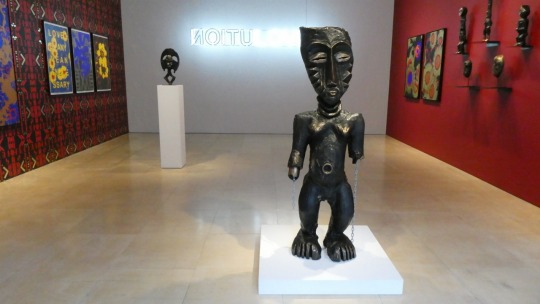
From THE PRESS RELEASE: A solo exhibition of new works by South African artist and curator Kendell Geers who lives and works in Brussels.
The title of the exhibition derives from the protest movements of the 1960s and is inspired by a statement by Malcolm X about the use of violence in political liberation. At the centre of the exhibition is a large-scale black and white neon spelling out ‘REVOLUTION' in reverse so that the hidden word ‘LOVE' reads forwards. The artist explains, "In the wake of more than a century marked by affluence, we now stand at a dangerous crossroads... The Land Rights Claims in South Africa, the fence along the USA border, abortion rights in Alabama, the European refugee crisis, the ‘gilets jaunes', Brexit and climate change are not separate problems, but all simply facets of one larger problem of disintegration, dissolution, alienation, denial, segmentation, prejudice and bigotry in the name of profit." In today's highly charged socio-political climate perhaps the most subversive act of all is to love. In the gallery window another neon spells out the letters FUC KING HELL. This play on words is characteristic of Geers' use of language in his practice. A wordsmith and a trickster, in this exhibition Geers aims to put love back into the revolution "by any means necessary".

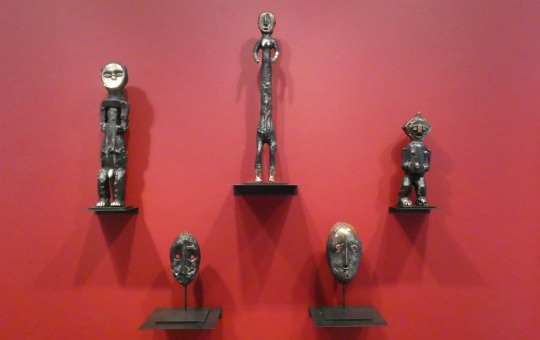
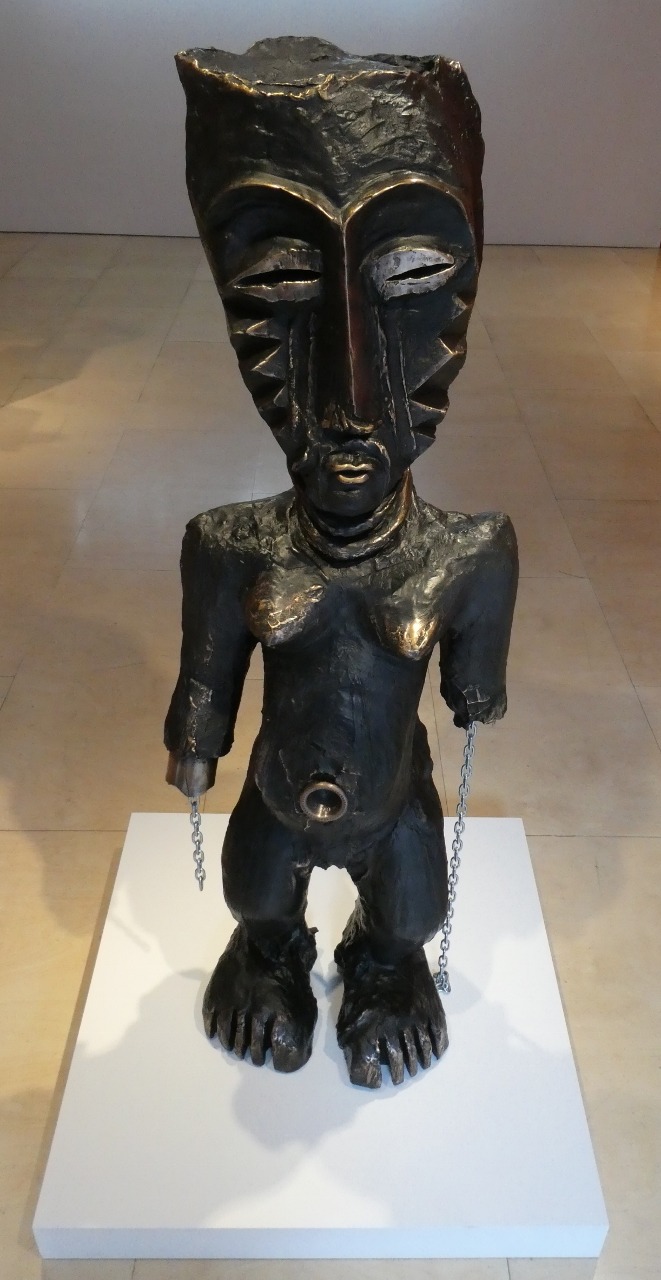
Geers also draws inspiration from the contradictions inherent in his identity as an African artist. Describing himself as an ‘AniMystikAKtivist', he weaves together diverse Afro-European traditions, including animism, alchemy, mysticism, ritual and a complex socio-political activism laced with humour and irony. A large bronze female figure stands like a sentinel in the gallery window. Her hands have been cut off and replaced with shards of glass. From each broken arm a chain dangles, resembling shackles from which she has liberated herself. A group of smaller bronze masks are influenced by Kota reliquaries, the first sub-Saharan African artworks to be exhibited in the West, examples of which were on display during Pablo Picasso's famous visit to Musée d'ethnographie du Trocadéro, Paris in 1907. In one of these works Geers has used a cast of his own mouth to close the mouth of the sculpture, bestowing it with "a kiss where art meets life".
Geers describes this exhibition as "a resurrection of spirit through an invocation of nature." A new series of paintings and works on paper, ‘Les Fleurs du Mal', is titled after a volume of poetry by Charles Baudelaire. Charged with an intense longing and melancholia, these paintings depict cut flowers whose petals simultaneously take the form of bullet holes or wounds. Severed from their roots and invoking a memento mori, the beauty of these blossoms lies in their fragility. The repetition of an emblem in these works is also inspired by Dutch wax batik fabrics, whose brightly coloured patterns are a symbol of African identity yet are designed in Indonesia and produced in the Netherlands. The investigation of repetitive patterns is also found in the artist's wallpaper that covers the gallery wall and teases the viewer's peripheral vision.
Geers creates work that aims to disrupt commonly accepted moral codes and principles. At the 1993 Venice Biennale he officially changed his date of birth to May 1968, a momentous year in world history for human liberation and equality. Employing a wide range of references- from the realms of history of art, pornography, iconography and kitsch- his work reveals razor-sharp humour that plays with the viewer's repulsion and ridicules racial or religious stereotypes.
3 notes
·
View notes
Text

hello im (F, 24) an idiot and forgot to post tessa’s (F, 22, fictional) intro!
pls bare in mind most of this was written 5+ years ago n i haven’t written tessa since 2015...... but lets get this show (LOCKWOODRP) on the road (DASHBOARD).
tw school shooting, tw bipolar disorder
art hoe. always covered in paint. why?? she bad at painting
the mark rothko jackson pollock kind of bad tho wher people are like.... omg.... revolutionary..... its a badly drawn vagina
fuckin loves astrology, but cant take it that seriously bcos one of her bfs was a gemini so there’s some lenience there. but she WILL blame her hormones and mood swings on the positon of mars
embodies pure sunshine.
one of those really annoying people that can go through the most traumatic shit and still find a positive spin.
cares so much for others but does not really care for herself n it’s meant she just bottles up all this shit n when someone asks her how her day has gone she just falls on the ground like tht bit in midsommar when florence does that loud wheezy noise and sits down
has never really had much money at all. learns to make-do with what she has. loves upcycling!! her bookshelf is made from cardboard which she’s reinforced by pappering it over with pages ripped out of thrifted books. her sofa is an old car boot which she’s repainted, put on wheels and stuffed w cushions so that it’s actually bearable to sit on.
her knitted cardigan? its made out of wife material.
knits all the time. will crochet you a christmas scarf. if ur lucky you might get a knitted jumper with a penis in a santa hat
still sleeps with cuddly toys n then wonders why ppl dont think she’s mature enough for a serious relationship
very passionate about Sister Doing It For THemselves!! raised by a single mom who worked her ass off so that tessa could do fun activities after school, have lelli kelly shoes, and go to college (not necessarily in tht order of importance)
tessa was born out of wedlock as the result of an affair between her mom (a journalism intern in her early 20s) and a new york times editor.
the editor offered to pay tessa’s mom off to have an abortion, but she was like fuck u and told the papers he’d done that and used the money to cover the cost of her internship which they refused to pay her for
and because of the scandal, he ended up going through a pretty messy divorce with his wife, and losing custody of his kids. so as a child tessa was seen as the cause of a divorce and received mutliple letters from the editors wife (to tessa personally!) and his kids saying how she had ruined everything, but her mom moved them to another town so tessa didn’t have to deal with that crap.
her mom worked 3 jobs to put her through school, so in return tessa pushes herself incredibly hard to succeed. needs a break and a hug and to get laid to be honest.
an old soul. likes old films, old music, old people. only recently got an iphone 5s so not really with this century yet
very sweet and soft and kind but also a fucking mess and won’t listen to anyone else’s opinion. she’ll take comfort, but not advice.
feminist buddhist bisexual vegetarian for human rights and animal welfare. standing on a soapbox shouting about the climate in the quad, shoving flyers into your hands. flyers everwhere. she turns up at your grandmas funeral and shoves one into her mouth. she’s stolen the mic from the vicar to talk about pandas.
says “mother of pearl” and “heavens to betsy”.
had an affair with her married piano teacher and he’s now facing a custody battle and his wife is leaving him and tessa has completely internalised that guilt despite her being the victim in the scenario
aesthetics: paint splattered jeans, loose curls spilling from a scrunchie, thrifted blouses in bright yellow, guzzling coffee in the library at three am when a term paper’s due, shoddily illustrated campaign posters to save endangered species, polaroids plastered to your bedroom walls with scribbled dates on the frames, jumping into a stack of autumn leaves, jumping off piers in the summer months and stripping off your wet clothes on the beach, digging your thumbs into peaches to leave a bruise, smoking with the extractor fan on to hide the smell, bath bombs, letting the girls at lush rub samples all over your skin, cacti with knitted bobble hats, decorative pillows and sun and moon blanket throws, basic bitch fairy lights hanging from every single window, painting the name of the boys you’ve loved inside your wardrobe door.
studies fine art and philosophy, and wants to become either a lecturer or the first woman president. vibe wise, very similar to leslie knope, missy from big mouth, and basically the naive everygirl with a high opinion of themselves trope
gets drunk off like one double vodka lemonade because she’s small and she’s a pretty messy wild drunk. it’s when slutty tessa comes out, and the next day she’ll thoroughly regret every choice made and decide she’s never drinking again and cutting out all men and starting daily sudoko
on the cheerleading team and is a flyer, which she sees as a HUGE responsibility and she works really hard to make sure she’s on it for her team. one of those get up at 7am and go to the gym before school types its sickening
she had a really traumatic time at high school because there was a shooting in her school. she was in the next classroom when it happened, and she lost one of her friends in the shooting. she had to take two months off school, was diagnosed with depression and put on anti-depressants because of it. in her 2nd year of uni she was rediagnosed with bipolar disorder and anxiety, which she’s now on medication for. she can be really good for several months at a time and feel super creative and determined (she actually finds manic periods helpful for her creativity n art, n sadly sometimes doesn’t take her meds in these periods to push herself more which is obvs super bad.....). but when the bad periods come they can also last months n she had to take a semester out of school last year because of her mood, so she should be a senior by now but she’s retaking junior year
she attends weekly stress-management sessions prescribed by her doctor which she finds pointless.
very childish in the sense that she can only see her own point of view and kind of views herself as the “protagonist” and thinks her ideas are super important and life changing and she IS Destined for Greatness! despite being pretty much average af
pinterest board.
STATS
age: 22
height: 5'2"
positive traits: kind-hearted, gregarious, selfless, philosophical, open minded, idealistic, courageous, feisty, charismatic, loyal, adventurous.
negative traits: stubborn, hot-headed, reticent, escapist, self-destructive, easily led, naive, troubled, complicated, stepford smiler, envious, overdramatic, explosive.
distinguishing Marks: heart-shaped birthmark on the right of her chest, splattering of freckles across the cheeks during summer months, full lips, large eyes, porcelain features, long wavy hair, tattoo of a bird and a cage on her ankles and a basic bitch arrow tat on her wrist (srry to anyone with an arrow tat).
skills: jack-of-all-trades, talented pianist, perceptive, knows the correct way to throw a punch, good survival instinct, is able to remain calm in stressful situations, endures, artistic, excels in academic studies, hard-working and self-motivated, expert liar and talented actress.
likes: wolves, vintage thrift store fashion, old leather-bound books, left-wing democratic politics, cigarettes, poetry, John Hughes movies, cold coffee, hot tea, the sound of laughter, staying up til 4am having deep conversations, Tchaikovsky, having deep conversations about life, stationary, DC Comics, horoscopes, winged eyeliner, cats, knee-high socks, house music, abandoned buildings, studio ghibli, the smell of the earth after rain, Wes Anderson films, herbal tea, old people, solitude, esoteric things, the smell of freshly baked bread, Charles Bukowski, the moon.
fears: death, oblivion, global warming, losing those she loves, isolation, clowns, guns, enclosed spaces.
nicknames: Tess, T-Dog, Tessie, Socrates, Princess, Sunshine Girl, Florence Nightingale.
alignment: Neutral Good
MBTI type: INFP
BIOGRAPHY
tw school shooting
Her story begins with Cordelia Costello, a twenty-three year old college drop-out, turned beautician, turned columnist, turned intern at a local publishing company. She was a youthful, beautiful, siren of a women, always surrounded by an aura of enigma and an entourage of men. It was no surprise to the gossips in the office that within six months working at the company, Cordelia had added to her list another title – mistress to Franklin Hozier, the Editor of the New York Times. After two blissful months and three hundred and twenty seven orgasms, Cordelia decided she wanted a baby. Franklin laughed in her face. Feeling isolated and used, Cordelia continued her affair with her boss’ boss for another month, before deciding to take matters into her own hands.
It started with a turkey baster.
Soon the infant cries of a baby girl graced the world, her wrinkled skin puckered and pink as her mother held her in her arms, glancing upon the most beautiful thing in her life. Once Tessa, named after Cordelia’s favourite literary heroine, entered the world, Franklin left her life and things took a turn for the better. Despite living in a rented one-bedroom apartment in Staten Island, on what little money Cordelia had saved, Tessa’s childhood years were filled with nothing but the happiest of memories. Times were tough, but what they lacked in money, the Costello’s made up in love. While Tessa was at school, Cordelia did odd jobs cleaning, child-minding, working in local nurseries, in order to save up enough money to give her daughter the best start in life.
Despite what she had been led to believe by television shows and teen movies, the first few years of High School were some of the best years of her life. Tessa threw herself into a multitude of activities that High School offered her, including the drama club, the orchestra, choir, badminton and the school newspaper. While she certainly wasn’t considered ‘popular’ at school, Tess had a wide circle of friends and acquaintances. In fact, High School was a place where she made some of the greatest memories of her life, but come her final year, it was also a place where she was haunted by some of her worst.
On the January 17th of Tessa’s senior year of high school, a shooting took place in Westville High School. For two hours Tessa locked herself in a supply cupboard, her head between her knees as she tried to stay silent despite the screams of horror from the corridor. Eighteen students were caught in the crossfire, two of which were Tessa’s best friends. Bouquets of flowers, laminated photographs, Teddy Bears in cling-film bags attached to balloons littered the streets as families and friends came to pay tribute to the eighteen students withered before they had a chance to bloom.
It took two months of therapy before Tessa could return to school. Some of the survivors could never return due to the horrors that their eyes had laid witness to. Sometimes Tessa felt like a part of her had died with the friends that were stolen from her too soon, but one thought kept her going through: she had survived, she was alive and breathing, and she could not afford to loose a second of the precious time she had been granted on this earth. Despite the nightmares that continued to haunt her each night, Tessa found in the aftermath of the disaster a new sense of motivation. She began applying for scholarships for colleges without her mother’s knowledge, in the hope that her academic success would be enough to carry her through further education. Thankfully, it was, and after three torturous months of waiting Tess was offered an arts scholarship to her dream school, Lockwood University, where she hoped she could finally start to rebuild her life.
THE PRESENT:
Life at university was like a separate world. Students came and went like moths among the whisperings and the tequila and the stars. In this new world, Tessa was exposed for the first time in her life to alcohol, drugs, and the sexual appetites of other students her age – though she politely declined all three. Instead, Tessa threw herself into the vast array of activities in the hope that by distracting herself she could escape the terrible flashbacks that continued to haunt her. Tessa joined the lacrosse team, despite never having played before, and took up cheerleading discovering a new talent; she joined the musical theatre group, and the film club, and even set up her own acapella singing society. But despite how much she tried to throw herself into student life, her past hung around her like a bad smell, and with the added pressure of the Sinking Ships zine, Tess began to feel the weight of her secret tying her down like a pair of shackles around her wrists.
PERSONALITY:
If someone was to describe Tessa in a single word, it would most likely be ‘bubbly’, ‘open-minded’ or ‘sweet’. But they would be wrong – Tessa is not bubbly, or sweet, or stubborn, or hotheaded, or fiesty, or infectious, or any of the things the world see her as, but merely a numb and lonely echo of the gregarious, halcyon girl she once was. Tessa Costello was one of life’s enigmas. No one knew who she was, for to each person she met she wore a different mask – she dripped confidence, or was painfully shy; she was an exhibitionist, or a brooding wallflower; she took things too seriously, or not seriously at all. She was an actress and the world was her stage, each person she met a different member of the audience in the performance of her life.
In truth, Tessa no longer even recognised herself. Insecure, and self-destructive, she tried to hang on to the extroverted, mischievous pieces of herself that everyone had once loved, but day by day it got harder to know what lay in the vacant holes blown through her mind. While she was stubborn and hot-headed, Tessa always saw the best in people, which meant that she was easily led astray. While she had grown up learning to be street smart and astute, she was idealistic and allowed silly fantasies to cloud her mind. By nature, she was passionate, which lead her to misimagine and romanticise those she met. Despite the hell she had witnessed, and the anxiety that feasted upon her, she believed that people were innately good and that to have courage and be kind could cure anyone of their sadness – yet she was unable to cure herself.
TWITTER:
@500daysoftessa: i blame disney films and musicals for my high expectations of men
@500daysoftessa: i am in love with the boy who works at starbucks. today i asked for a double latte and he gave me a tripple, which i think is proof that my love is requited. our children will be smart and talented and beautiful.
@500daysoftessa: little known historical fact: pharaohs were burried with their hands crossed over their chests because it was a popular belief there would be countless water slides in the after life.
5 notes
·
View notes
Photo
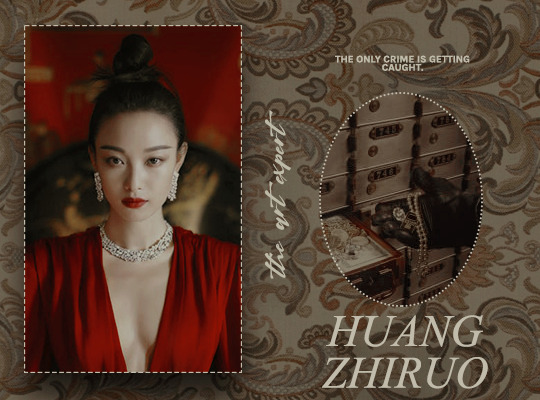
Our crime tale begins with HUANG ZHIRUO, a THIRTY-ONE year old member of THE PRESIDENT’S CLUB. SHE works as their ART EXPERT, better known as the infamous ZHAO. JOIN THE HEIST?
PART ONE; the basics
Name: huang zhiruo
Alias: rue (for any english speaking people/contacts who continue to butcher her full name)
Code name: zhao
Faceclaim: ni ni (chinese actress)
Gender/Pronouns: she/her
Date of Birth: august 19th
Age: 31
Hometown: guangzhou, people’s republic of china
Occupation: forensic artist
Canon: the art expert
PART TWO; about
Biography ( tw: n/a!)
THE ANATOMY OF A FAKE // HOW TO FIND A FORGERY
1. ESTABLISH THE PROVENANCE…..find the chain of ownership and custody of an artwork from the contemporary ownership back to its origin
there are perks to being adopted at an older age; she’s nine when it happens. generally, less affected by adopted family trauma or divorces, but the downside is that most come with a chip on their shoulder. infants are preferred, but sometimes there’ll be a family that wants an older kid. call it pretty privilege, but zhiruo only spends five months in the system before an older, doting, couple sees her big eyes and gentle smile. within two weeks she is adopted into an affluent family as an only child. it’s a good position to be in, and her smile turns sharper with the years as she realizes this.
she goes on to only attend private schools, receives an education like no other, and takes the opportunity to finish her university studies abroad. zhiruo lands herself a job in a field that most in her position wouldn’t even consider - criminal justice.
but it’s just a stepping stone.
after obtaining her degree, four year are spent doing her due diligence in a forensics laboratory as an assistant technician processing evidence from crime scenes. it’s a waste of her time, a waste of her mind, but more than that it’s a waste of her eyes. but she sticks to it because people underestimate her and assume she’s just a pretty face so they keep her around for the eye candy, unsuspecting that she’s paying close attention.
she absorbs a lot.
2. VISUAL ANALYSIS…..look closely at the painting to find anachronistic materials and techniques, something that would be uncharacteristic of a given artist or period of time
life on the streets with parents who heckle tourists to come check out their wares - it’s boring. she doesn’t like the people who walk by with their noses upturned, likes the ones that enthusiastically come and handle every bag with disgusting fingers even less. so, she turns her attention to the handbags and scarves themselves. every now and then they’ll get someone who comes in, trying to flaunt the fact that theirs is real, as if approval from some random local will elevate their status as a legitimate world traveler.
pathetic.
rarely does she touch, but she is a precocious, highly observant, child. by the age of eight she is able to decipher a fake louis vuitton from a real one on some blonde lady’s shoulder from a meter away (literally), based on the outside seam and hemming alone. call it a gift, but zhiruo considers it a hobby at this time.
when her parents get shut down permanently, one actually gets arrested for other outstanding charges and the other just disappears one day a few months after that.
so she’s alone, and she cries for three days, but then takes herself to the nearest police station four months from her ninth birthday.
3.. X-RAY FLUORESCENCE ANALYSIS…..art forensics uses tools to emit a small amount of x-rays to excite electrons in the pigments of paint, allowing identification of what elements exist
it started with the different patterns of fake designer handbags. then it was the art history education during her formative years courtesy of her parents (thanks, huang kaijie and feng lairan!). and then it was the visits to any and every museum out there. and then repeat visits to galleries whenever they’d get new exhibits. then an almost obsession over the classical painters of all different eras across countries — and then she’d turn her attention to the modernists.
by the time she enters college she’s certified obsessed, and she plays it off as a hobby but it’s a lifelong passion; she feels it in her bones.
but art isn’t a field that can guarantee a good future, so she defers to the next best thing in her eyes, the forensic arts.
4. PHOTOGRAPHY & ULTRAVIOLET ANALYSIS…..are there any sketches or under-drawings under the paint?
the case that changes things for her involves a purported jackson pollock piece, a mysterious fax with a chain of information, and a missing person. her supervisors struggle. immensely. the fact that it’s an abstract drip piece confounds them, and after a few hours staring at curved drips of paints and small puddles of collected alkyd enamels, they give up.
she timidly asks to take a look, and they step away, gloves snapping off as they entertain the idea of her giving a try.
within less than two hours she’s able to determine that although there is titanium pigment within the paint, which WOULD validate it as a pollock piece, there’s under-drawings that aren’t within his usual sketch, and that the canvas itself is re-purposed.
within another 3 months, she quits her mindless job, and contracts out her specialty. she generates buzz and makes connections for the next two years, traveling from country to country, lending her skills to both criminal and personal cases (because rich people have the most expendable income to throw at a pretty lady).
she appears commonly at high profile art auctions, and when you see her there, you know that there’s bound to be some rare pieces in the auction rotation. when a piece receives her seal of approval, the bidding is bound to go up by a few million.
the excess is almost disgusting, especially considering where she came from, but it’s enough for her to be selective in her projects for the next three to four years.
then, she’s approached by tall dark and handsome (eh, kind of) with a two part posse and they make her an offer that’s almost too good to refuse.
she doesn’t, but zhiruo makes them sweat it out for a few days before she accepts.
5. MICROSCOPY…..take tiny non-destructive microscopic fragmentary samples of bits of paints to test both the pigment and the binder (what kind of paint is used?)
you live your life in extremes. it’s all or nothing. you’re in gaudy, ugly, baggy clothes with your oversize glasses on or you’re in tight-fitting dresses that cost upwards of the hundreds. your mouth is either in an almost permanently straight, unimpressed line, or red lips are pulled wide in a smile that reveal perfect teeth. the only thing that remains expressive and fluid are your eyes. for as much as you try not to reveal too much to the outside world, your eyes give you away and you may hate it but it’s not something you’d pour energy into changing.
there are bigger and better things to think about.
like…if that new museum will have enough pull to borrow a monet from the metropolitan.
now that — that’s something delicious to sink your teeth into.
–
1 note
·
View note
Text
[PAPERBACK/HARDCOVER] Kovels 2021
adakah anda mencari buku ini?
Van Gogh By Steven Naifeh

Book Excerpt :
Steven Naifeh and Gregory White Smith galvanized readers with their astonishing Jackson Pollock: An American Saga, winner of the Pulitzer Prize for biography, a book acclaimed for its miraculous research and overwhelming narrative power. Now Naifeh and Smith have written another tour de force?an exquisitely detailed, compellingly readable, and ultimately heartbreaking portrait of creative genius Vincent van Gogh.Working with the full cooperation of the Van Gogh Museum in Amsterdam, Naifeh and Smith have accessed a wealth of previously untapped materials. While drawing liberally from the artist?s famously eloquent letters, they have also delved into hundreds of unpublished family correspondences, illuminating with poignancy the wanderings of Van Gogh?s troubled, restless soul. Naifeh and Smith bring a crucial understanding to the larger-than-life mythology of this great artist?his early struggles to find his place in the world; his intense relationship with his brother Theo; his
>>> START READING NOW
"This book is available for download in a number of formats - including epub, pdf, azw, mobi and more. You can also read the full text online using our Ereader."
#BESTSELLERS, #KINDLE, #BESTSELLERBOOK2020
0 notes
Text
HNC Contemporary Fine Art and Photography
Emma Smyth
2/11/2020
Folio 1 Section 2: sound art research
Christian Marclay
Biography
Christian Marclay is an American sculptor, video artist and musician who was born in 1955. He was born in California and raised in Geneva, Switzerland. Marclay studied at the Ecole Superieure d’Art Visual in Geneva between 1977 and 1980. During the same period, he also studied sculpture at the Massachusetts College of Art in Boston. He currently lives in New York and is represented by the White Club Gallery in London.
Context of artwork
He combines music with secondhand objects by molding these familiar topics into unfamiliar ones. Marclay was the first to bend and form sounds by using a turntable to create new sounds. Marclay uses his talent as a DJ and filmmaker to produce installations as well as film and video collages. One of his early pieces is “Recycled Records (1980-1986)”, in this piece he rebuilt record fragments into objects that distorted tone and sound and the final project could be played. His Body Mix series merged album covers together to produce postmodern critiques of visual and music culture. One of the main aspects of Marclay’s work is his morphing of musical objects into discussion about culture.
Marclay continues to deconstruct records into sounds and theories that revolve around music and culture and incorporates into his amazing and unique artworks.
Music, noise in general, rhythm and everything in-between has played a huge part in Marclay’s practice. Marclay is influenced by music-art crossover exploding in the city at the time for example, Dan Graham and Laurie Anderson.
Analysis and definitions of techniques in the art works
Screams: Is a series of expressive prints that are created through a combination of collage, digital technology and traditional printmaking techniques. Sections of screaming faces are cut out of Manga books and many other comic books and collaged into new composite faces that look very haunting, odd, unique, unusual and have a mask-like quality. The faces are usually crying or sweating which conveys a silent yet explosive energy.
Cyanotype: Through his career Marcley has often given older or defunct audio technologies a purpose. He uses them for collages, sculptures, installations, photography, video and performance. Here Marclay combines cassette and the cyantype. Almost looks like a blueprint due to its bright and distinctive Prussian blue color. Cyanotype is created by placing objects directly onto a photosensitive surface, producing a silhouetted image similar to a photogram. Marclay’s cyanotype is the abstract tangles made by cassette tapes unspooled onto the print surface, resulting in images and tones that equally evoke the painting of Jackson Pollock and the monochromes of Yves Klein.
The clock: One of Marclay’s most hypnotic pieces is “The Clock”, which opened in London during 2012. The concept of this piece is quite straightforward: to splice together film scenes displaying clocks into a full 24-hour piece, because of this piece he earned a Golden Lion award.
Bibliography
http://www.artnet.com/artists/christian-marclay/biography
http://www.dazeddigital.com/artsandculture/article/23621/1/christian-marclay-the-art-of-sound
https://www.goodreads.com/book/show/13488010-cyanotypes





1 note
·
View note
Photo
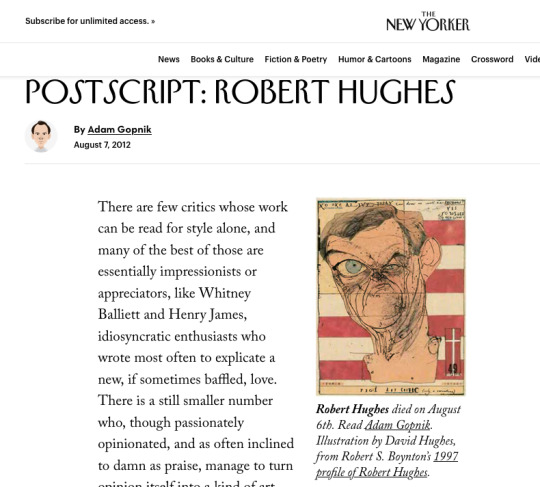
There are few critics whose work can be read for style alone, and many of the best of those are essentially impressionists or appreciators, like Whitney Balliett and Henry James, idiosyncratic enthusiasts who wrote most often to explicate a new, if sometimes baffled, love. There is a still smaller number who, though passionately opinionated, and as often inclined to damn as praise, manage to turn opinion itself into a kind of art form, who bring to full maturity the moral qualities that hide in violent judgment—qualities of audacity, courage, conviction—and make them come so alive on the page that even if the particular object is seen in a fury, the object seems less interesting than the emotion it evoked, while some broader principle always seems defended by the indignation. Of that still rarer kind, those who come first to mind in English might be Tynan and Shaw on the theatre, Johnson and Jarrell on poetry—and to those names must be added that of Robert Hughes, the Australian (and, latterly, American) art critic, who died this week.
Hughes was many kinds of writers—his hugely popular account of Australia’s founding, “The Fatal Shore,” and his two marvellous books on the cities he loved, “Barcelona” and “Rome,” as well as his biography of Goya were all memorable in their kind—but his fame rightly rested on his thirty or so years of art criticism for Time, and (as he knew) above all on the series and book “The Shock of the New,” still much the best synoptic introduction to modern art ever written. “Nothing if Not Critical” was the title, taken from Iago, that, with mordant self-mockery, he used for a collection of his criticism. And he was a pure critic: both his memoirs and his essays on cities came most alive when he was laying into someone, or pouring praise on something, explaining why one fountain in Rome is more beautiful than another, or why someone he met in the course of life was not beautiful at all. The critics’ work was his work—not disclosing, but describing, fixing, defending, denouncing.
He was, first of all, an artist who just missed having a career as one—as a young man, a cartoonist, his line was said to be ridiculously, fluidly nimble. (There is a wonderful portrait of the young, inspired, angelic-looking Hughes in Clive James’s “Unreliable Memoirs”; indeed, a fine biography might be written of Hughes and James and of the conquest of Anglo-American opinion by Australian energy and unspoiled ambition.) He thought with his hands. When he was defending a notion of permanent value in his mid-nineties “culture war” polemic, “The Culture of Complaint,” it wasn’t with a sniffy reference to Plato or Dante, but through his direct experience as an amateur carpenter, of the practice of planing, sawing, varnishing, and getting it right. There were good tables and bad tables; master carpenters to make them well and miserable ones to make them badly. Craft attempted with passion—that was his critical touchstone. Though it was part of his achievement to help end for all time the notion that novelty in art is in itself a virtue, or that “radicalism” or progress was in any way a reasonable end for creativity, he did so without becoming a reactionary. He had only contempt for the cheap smug conservative taste that risked nothing and tried no new thing, and rooted its suspicions in bile and bad faith. He much preferred a rough-worn and unvarnished table made by passionate hands to a smooth one made to pattern.
His values rose not from some distant imagined past, but from the European modernism that still vibrated with excitement in the Australia of his youth, where no one yet knew it well enough to have grown tired of it. Shaped—some might say scarred—by a resolute Jesuit education, Hughes had as a teen-ager drunk in the images and ideas of that faraway modernism without the least touch of complacent familiarity. (Mechanical reproduction heightened, enhanced its value for him.) In the same way that his contemporary Barry Humphries relished the dandy-art of the eighteen-nineties in a way that few Brits could, or that Clive James kept faith in the power of the heroic couplet to communicate, Hughes believed in modern art with something close to innocence. Although “The Shock of the New” is in many ways an account of the tragedy of modernism—the tragedy of Utopias unachieved, historical triumphs made hollow, evasions of market values that ended by serving them—that tragedy is more than set off by the triumph of modern artists. The thesis of “The Shock of the New,” if such a work can be reduced to one, is that what art lost when it could no longer credibly be a mirror of nature it had gained as a transmitter of lived experience, so that, if the surface of the world had been ceded to the photographic image, the essentials of existence—desire in Picasso, physical ecstasy in Matisse, or the agonized alienation in Giacometti, or all of them at once in Van Gogh—could now be expressed with newfound urgency.
Hughes had an impressive line in indignation, but he was allergic to irony. If he seemed at times out of place in New York it wasn’t by virtue of unorthodox opinions; it was because of a kind of robust, unashamed absence of irony, or meta-awareness, in his work, an absence of sentences placed in inverted quotations or of any despair about the ability of plain speech to achieve plain ends. What he really detested was mannerism, in all its guises, whether the mannerism was the Italian kind that had to be cured by Caravaggio or of the postmodern kind that had yet to be cured at all. If this left him blind to the virtues that mannerism may contain—elliptical thought, the tangle of reference, stylishness—well, who would not want to be in a minority clamoring for truth and passion in a mannerist age?
A radical conservative, a skeptic about the avant-garde in authority who relished the trespasses and achievements of the avant-garde in opposition, he was like Swift, someone who had been driven into reaction only by the excesses of the reforming party in power. He could be rough and even brutal, and, like every critic, his hits and misses are, in retrospect, in about even balance. The odd thing was that, in conversation, he was immune to the habit of turning differences of taste into differences of value. If you explained to him why, say, Jeff Koons or Damian Hirst was not quite the monster he had imagined, he would listen patiently, and then sum up your wavering, hesitant hems and haws in a neat phrase: “Hmmmn…Well, Yes. You’re saying that Koons is to sex what Warhol was to soup cans?” A machine gun burst of laughter. “All right, then!” As with all first-rate writers, the bite, and even occasional bluster, was covering up something, and in Bob’s case this was an enormous vulnerability: to experience, to people, to art. The images that arrive from a quarter century of sporadically intense friendship are not of enemies excoriated but of gentle gestures attempted, of poetry recited and far-distant masterpieces evoked.
Advertisement
“Ah, yes!” was his usual start to a sentence, eyebrows raised in memory followed by the single name of whomever or whatever was about to be quoted or praised or described: “Ah, yes! Auden!” he would say, and then he would give you, from memory, the entire nativity section from “For the Time Being.” (I knew no contemporary writer of any kind who had so much poetry committed to memory; it was part of the rote-learning side of his Jesuit education.)
He was as touching a man as you could hope to meet: when our first son was born, Bob arrived at our loft with arms full of stuffed Australian animals for the newborn. “Now this, you see—this is … the Joey!” he said, showing him the baby kangaroo in its pouch, as though he were describing a work by David Smith. (When, a decade later, he called in the middle of the night, with the news that his only son, Danton, from whom he had long been estranged, but loved all the same, had taken his own life, it was with a desperate, apologetic grief that I have not, and hope never again, to hear equalled.) And, above all, he was a writer: I write this far from both from the Internet and from my own library and yet Hughes’s sentences and phrases stick in my head without either having to be consulted. For all the violence of his disdains, they are mostly phrases of enthusiasm: his insistence that Eric Fischl’s suburban vision “smells of unwashed dog, Bar-B-Q lighter fluid and sperm,” his evocation of the nineteenth-century American landscape artist as “God’s stenographer,” his description of a Morris Louis stain picture as “the watercolor that ate the art world,” or, more profoundly, his explanation of the rococo play of line and painterly weather in a Jackson Pollock and of how it belied his reputation as a mere paint-thrower.
He loved most of all art that danced on an edge between manifest accomplishment and audacity, where a painter managed to bring his or her sheer talent to bear upon the world—and then made the inadequacy of talent alone to bear adequate witness to the world manifest, too. The painters of the London School, which he did so much to raise in the world’s estimation, earned his trust because they echoed his virtues: a love of craft married to an allergy to mere elegance; a feeling for the life-giving qualities of healthy vulgarity and a love of life and the world as it really is, displayed without apology. The smears and howls and broken lines and awkward bodies, the will to truth evidenced in the open, blunt statements of Bacon and Auerbach and Kitaj and Freud—these artists were not so much his best subjects as his truest equivalents.
Criticism serves a lower end than art does, and has little effect on it, but by conveying value it serves a civilizing end. If Bob’s last years were in many ways sad, and at times agonized by the pain that his horrific 1999 automobile accident had left him, the work never stopped, and his affection for those round him never dimmed. Through it all, his mind would rise and a phone call would arrive, and one would race downtown to spend time with him; he would read page after page of whatever he was working on, reciting, in his gruff, warning voice, some masterly combo of verdict, examination, evocation, summary—and then, being Bob, look up, anxious as a schoolboy, and say, “But do you think it’s any good? Do you, really?” It was so much better than good that no good words came to mind. At the end of the evening he would dismiss you, as one raised Catholic and still surprised in the presence of the world, with a simple, “Bless you!” His writing will live as a repository of experience fixed in place by a consciousness tormented but never overthrown, and his memory will survive not as some hanging judge of the museums but as one of the indispensable mavericks of modern humanism.
Illustration by David Hughes, from Robert S. Boynton’s 1997 profile of Robert Hughes.
0 notes
Photo
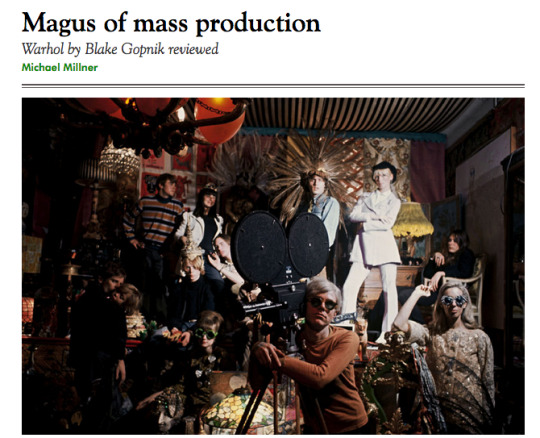
Lovely review of my Warhol bio by Michael Millner in the US edition of The Spectator:
“An extraordinary and revealing biography — surely the definitive life of a definitive artist….There is something interesting, revealing or humorous on just about every page. Gopnik deftly excavates his data mine. His prose is precise and pointed, and his year-by-year narrative clips along. He is also a master of pithy and informative character and historical sketches.”
Magus of mass production
Warhol by Blake Gopnik
Ecco, pp.976, $45.00
reviewed by Michael Millner
This article is in The Spectator’s April 9, 2020 US edition.
‘If you want to know all about Andy Warhol,’ the artist said in the East Village Other in 1966, ‘just look at the surface: of my paintings and films and me, and there I am. There’s nothing behind it.’
This quotation re-appeared in 2002 on the US Post Office’s commemorative Warhol stamp. It’s fabulously fitting for a stamp that reproduced a self-portrait, but when scholars recently compared the audiotapes of the interview with the printed version, the passage wasn’t on the tapes. Warhol sometimes invented interviews from whole cloth. He answered questions with a gnomic ‘yes’ or ‘no’ or, refusing to speak at all, allowed proxies like his ‘superstar’ Edie Sedgwick to answer for him. After all, he was just surface — leather jacket, shades, wig. The magus of mass production was there and everywhere forever, but nowhere in particular.
This negation of personality seems a publicity ploy, or the evasiveness of a shy man, or possibly the self-protection of a gay man in pre-Stonewall America. It was all of this, but also much more. The self-as-surface routine was perfect for a new kind of celebrity, one founded less on accomplishment and talent and more on presenting a surface for the projected desires of a mass audience. Authenticity and the sense of a deep self were obstacles to the creation of this new celebrity persona. Warhol made millions by autographing screen prints that were mass-produced by anonymous assistants.
Warhol somehow understood how this all worked. Born in 1928 in Pittsburgh to working-class Catholics from eastern Europe who barely spoke English, he realized the power and danger of being known to the world. The flipside of ‘15 minutes of fame’, Warhol suggests again and again, is death. The paintings of Marilyn Monroe memorialized her suicide; those of Jackie Kennedy, her suffering following her husband’s assassination. After Warhol survived his own assassination attempt in 1968, he allowed Richard Avedon to photograph the surgeon’s scars that crisscrossed the surface of his torso.
There is no narrative development or personal bildungsroman in Warhol’s art, and his affectless manner resists psychologizing, the biographer’s stock-in-trade. His images are impressions, flashes whose immediacy, flatness and repetition carry little sense of progression. The Brillo box contains no story, and the subject of a film like Empire, with its eight hours of static footage of the Empire State Building, remains inanimate.
Despite Warhol’s resistance, Blake Gopnik has written an extraordinary and revealing biography — surely the definitive life of a definitive artist. He accomplishes this through broad and deep, even obsessive, research into what he calls Warhol’s ‘social network’. Gopnik reports that he consulted 100,000 period documents and interviewed 260 of Warhol’s lovers, friends, colleagues and acquaintances. Warhol kept everything — he was a hoarder, collector and archivist all his life — and Gopnik has left no archival folder unopened or box unperused. Across 976 pages and more than 7,000 footnotes on a separate website, he recreates the swirl of ideas, culture and especially
people that orbited Warhol.
Warhol famously thought of his studio as a factory, producing work after work off an assembly line. The catalogue raisonné of his paintings, drawings, films, prints, published texts and conceptual works would, if it were ever completed, rival that of the other master of 20th-century self-replication, Picasso. Gopnik has surveyed it all.
There is something interesting, revealing or humorous on just about every page. Gopnik deftly excavates his data mine. His prose is precise and pointed, and his year-by-year narrative clips along. He is also a master of pithy and informative character and historical sketches:
‘Warhol’s Pop wasn’t about borrowing a detail or two from commercial work, as many of his closest colleagues [like Robert Rauschenberg] did; it was about pulling all its most dubious qualities into the realm of fine art and reveling in the confusion they caused there. ‘He wants to make something that we could take from the Guggenheim Museum and put it in the window of the A&P over here and have an advertisement instead of a painting,’ complained one early critic of Warhol’s, getting it right, but backward: Pop pictures started in the windows and then migrated to the museums.’
Warhol is about the Age of Warhol as much as Warhol himself. We learn about the new possibilities of gay life in 1950s New York, the city’s underground film scene, the history of silk-screening (so important to Warhol’s art), the fluctuations of the art market, the history of department-store window design. We learn about fascinating things we may not even want to learn about, such as the size and color of Warhol’s penis. (Large and gray, like the Empire State Building.)
Warhol arrived in New York City in 1949 and quickly made a name for himself as a commercial illustrator, especially of women’s shoes. He lived for two decades with his mother, Julia, one of his most influential muses, and sought out an emerging coterie of gay artists including Truman Capote, with whom he had a stalkerish infatuation. The great Pop paintings of the early 1960s transformed American art. No less important was Warhol’s mid-Sixties salon and studio, the Silver Factory (silver because wallpapered in aluminum foil). This perverse and fecund anti-commune of ‘superstars’ and hangers-on spawned Lou Reed and the Velvet Underground, as well as Warhol’s wannabe assassin, Valerie Solanas. On June 3, 1968, Solanas shot Warhol in the name of feminist revolution. His heart ceased beating on the emergency room table before a determined surgeon saved him. In the 1970s, he turned to what he called ‘business art’, mainly portraits of other famous people. He died in 1987, aged 58, after gallbladder surgery. Gopnik unpicks many of the conventions of Warhol’s non-biography. Warhol wasn’t an aesthetic rube when he arrived in New York. He had received an extraordinary avant- garde education from four years at the Carnegie Tech art school and at the Outlines gallery, which had brought Jackson Pollock, Alexander Calder, Joseph Cornell, Francis Bacon, Merce Cunningham and many other transformative artists to Pittsburgh in the 1940s. Warhol did not suddenly reinvent himself as a Pop artist in the early 1960s. As he built a successful career illustrating advertisements in the Fifties, he regularly tried to cross the line between commercial and fine art — a crossover he finally achieved in late 1961 with ‘Campbell’s Soup Cans’.
Warhol was baptized ‘Drella’ by acquaintances — part bloodsucking Dracula and part innocent yet social-climbing Cinderella. But Gopnik also argues that one of Andy’s greatest desires was for compassionate companionship. This was never achieved. The ‘routine’ gallbladder surgery which led to his death was anything but routine. He had been very ill for weeks but avoided treatment out of a lifelong fear of surgery and a misplaced faith in the healing powers of crystals.
Emphasizing Warhol’s radical ambiguity in art and life, Gopnik makes it impossible to say anything easy about him. His Warhol is a complex artist practicing what Gopnik, in a marvelous turn of phrase, calls ‘superficial superficiality’. The Warhol brand, the images of branded goods, famous faces and dollar bills, celebrates consumerism but also leaves us a little nauseated from our commodity fetishism. Warhol’s endless ‘boring’ films are hard to ignore because they give us so much space and time to think. They are studies in modern emptiness, and thus deep meditation. Warhol the critic of modern celebrity was also one of its greatest adulators.
This double image of Warhol seems just right. ‘His true art form,’ Gopnik writes, ‘first perfected in the first days of Pop, was the state of uncertainty he imposed on both his art and his life: you could never say what was true or false, serious or mocking, critique or celebration... Examining Warhol’s life leaves you in precisely the same state of indecision as his Campbell’s Soup paintings do.’
Gopnik’s analysis of Warhol’s ambivalence evokes another great observer of midcentury American culture. Lionel Trilling, the gray-suited lion of Columbia’s literary studies, would have hated Warhol, had he deemed the Silver Factory worthy of a visit. Still, Trilling’s America is Warhol’s:
‘A culture is not a flow, nor even a confluence; the form of its existence is struggle, or at least debate — it is nothing if not a dialectic. And in any culture there are likely to be
certain artists who contain a large part of the dialectic within themselves, their meaning and power lying in their contradictions.’
To Trilling, the great American authors contained ‘both the yes and the no of their culture, and by that token they were prophetic of the future’. Warhol absorbed and reflected the affirmations and negations of his America — but was he prophetic of ours?
Yes and no. For a long time now we have lived in the Age of Warhol. If he were alive today, he would film us staring blankly at the social networks on our smartphones, hour after hour, while nothing and everything go on and on. By retaining ambivalence, Warhol allowed us to recognize and experience the deepest ethical dilemmas of American life — and he paid a price for being our screen and mirror.
0 notes